#this has unfortunately been my calamity review so far :/
Explore tagged Tumblr posts
Text
Hhh scraping and clawing my way thru exu calamity and it's kinda frustrating how. Everybody loves it so much?? And it's def much better than the other exu's but I'm just having heavy brainrot for c3 specifically and I want to get back to the main characters and plot!! Don't get me wrong I'm super enjoying brennan as a dm and everyone having fun but I just feel bad bc I'm not enjoying it as much as I feel I should and I'm just. Not attached to these characters or whatever plot happens bc it's all in the past and I'm assuming they all die anyways so I'm just having a hard time w it. :<
#ignore me#maddie liveblogs exu#do I need a calamity specific tag hm#maddie liveblogs calamity#sure why not#this has unfortunately been my calamity review so far :/#it's not fair bc it's good?? just not what I want??#but I don't want to skip it so I'm just painfully slogging thru#I've got one ep left..... 6 hrs tho jfc.......#doesn't help that I've listened to most of it while busy at work so I've been less focused and keep losing details#idk man I just kinda feel bummed about the whole thing#hopefully there's a recap I can check out afterwards?#I will say the bit w purvan suul (sp??) was such a blessing. finally some familiarity lmao.
1 note
·
View note
Text
The Great Wave - Chapter 4 Review
‼️ SPOILERS FOR THE CHAPTER ‼️
This might just be the weirdest chapter so far.
Because what just happened???
Meanwhile, far away from Aurora’s bullshit, we go to the borders of Amakna. And not gonna lie, I just feel genuinely surprised by that one town they got us to zoom in on.
You’re telling me that after all those centuries, there are still regions that haven’t been touched by ANY calamities?? Really? NO CALAMITIES?
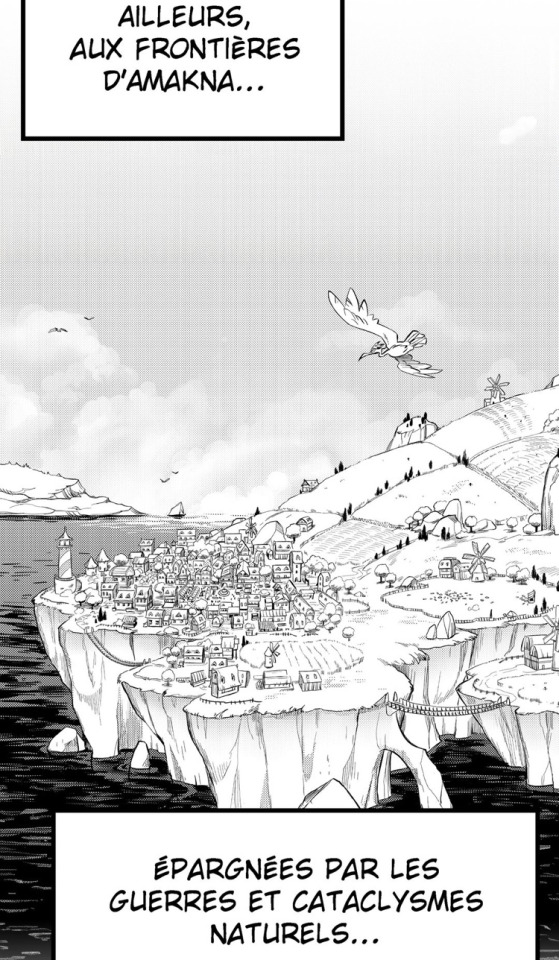
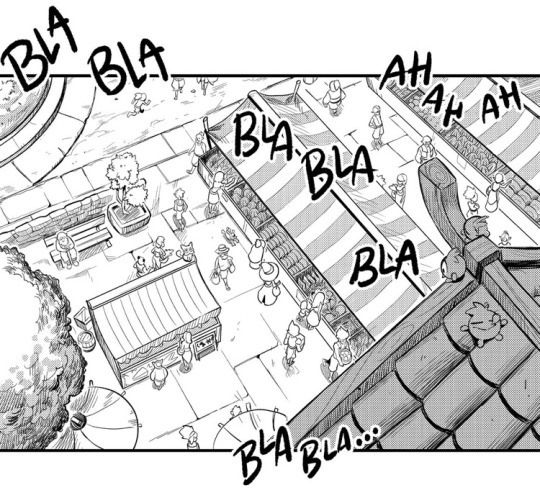
First panel:
Elsewhere, on the borders of Amakna.
Spared from wars and natural cataclysms…
These people either live very far away from other regions like Frigost or their villages are just way too small to ever be noticed by danger itself. With all the stuff we’ve seen in the World of Twelve and how many disasters people have been in, it’s just so odd to see that there are still places in the world that have never been affected by anything before.
I don’t know why but just seeing these people having fun and enjoying life makes me sick.
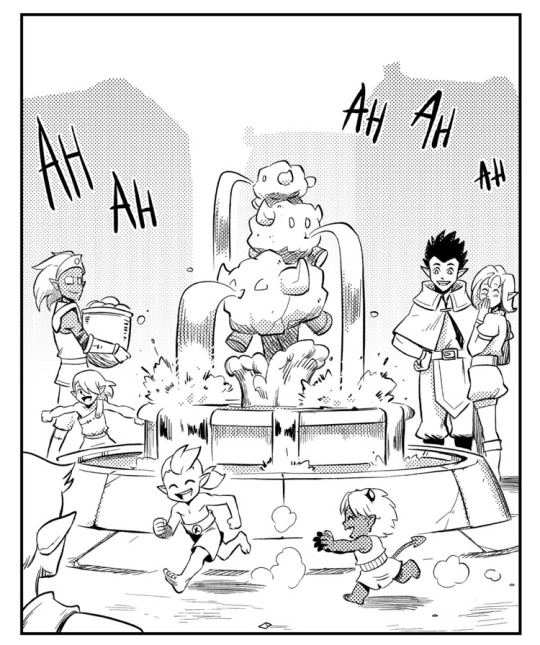
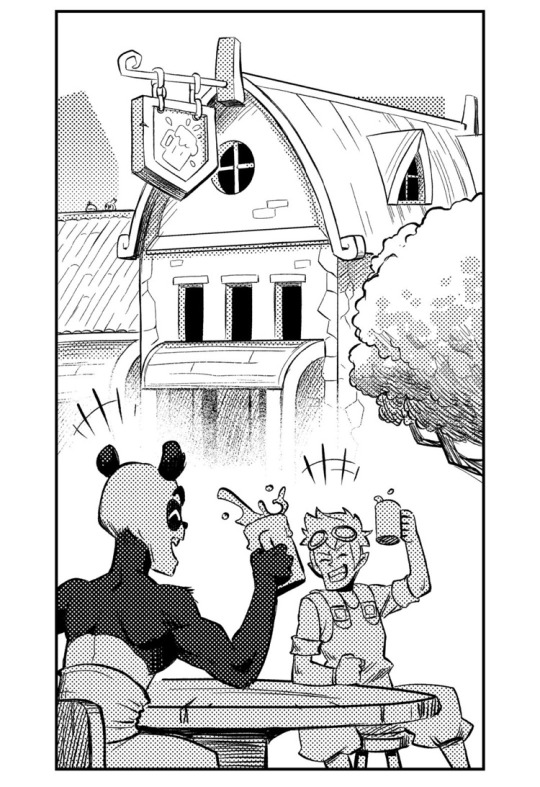
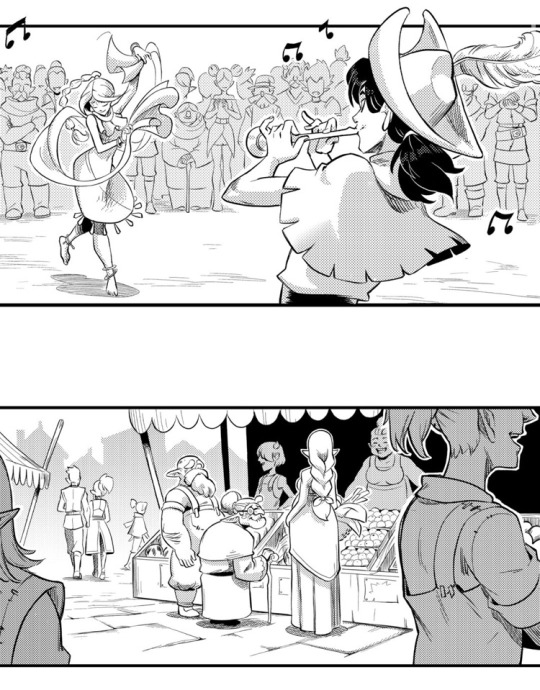
Like what do you mean they’re not suffering or have never heard of any danger??? Don’t these people know what stress is???
People are even giving each other kamas as if it were nothing. They support each other and help no matter when or where they are or with who they are.
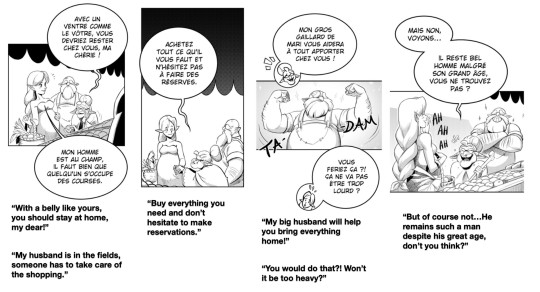
This is way too good to be true, they just HAVE to suffer.
And as if my prayers have been answered, here comes the part where it all goes to shit 🥰 Except that this wasn’t what I was expecting… AT ALL.
BECAUSE WHY IS JULITH HERE?!!??
And I STILL haven’t figured out who’s the dragon with the Ebony dofus! (he’s kinda sexy-looking tho ngl)
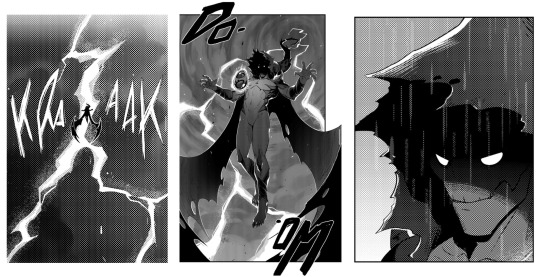
I refuse to believe that that’s Grougalorasalar because why on earth would he be the one to hate Yugo after he PURPOSELY JOINED IN OGREST’S CHAOS??? Bro is hating on a traumatized man who grew up in a day cuz he accidentally created a calamity but didn’t mention the fact that he himself PARTICIPATED IN A CALAMITY.
So for now I’ll just call him “the dragon”.
We can see how the dragon makes his appearance and immediately starts sucking out the souls of these villagers, which is not only a huge reference from the Dofus movie, where Julith has used that same technique with the exact dofus to try to revive her husband Jahash, but is also what the dragon is intending on doing by reviving Julith.

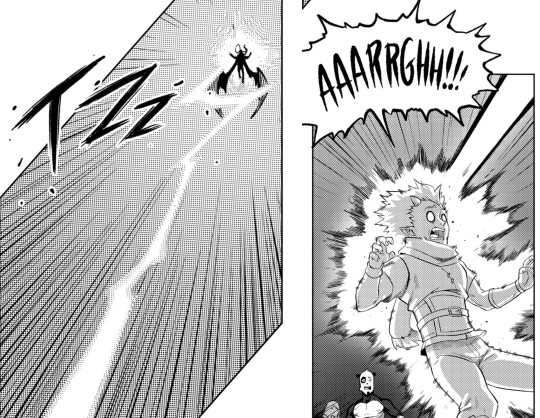
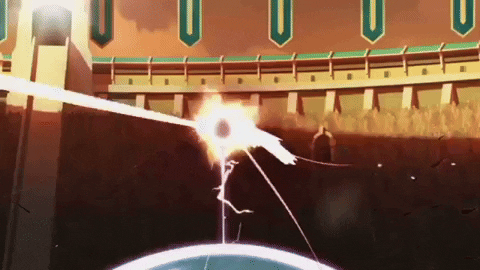
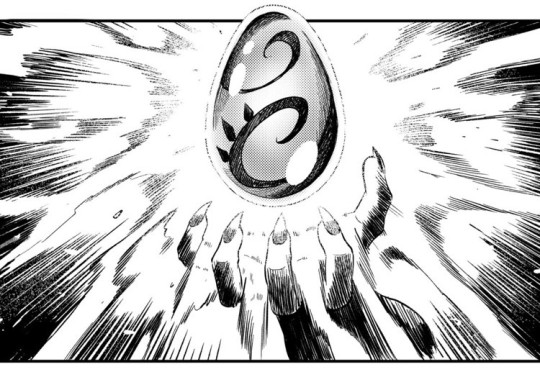

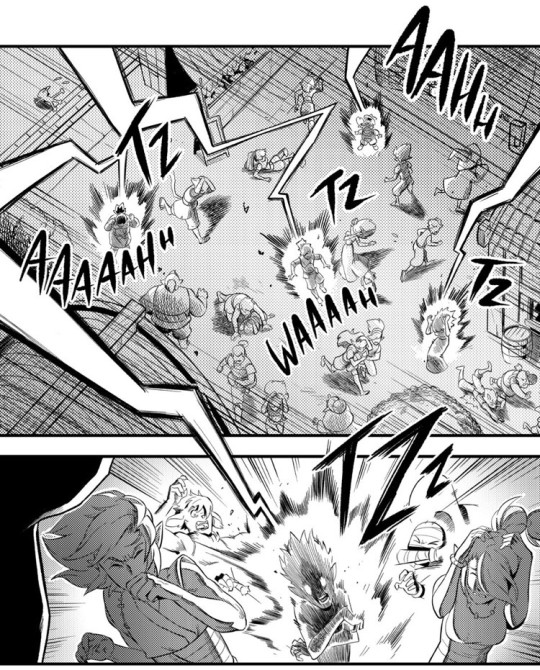

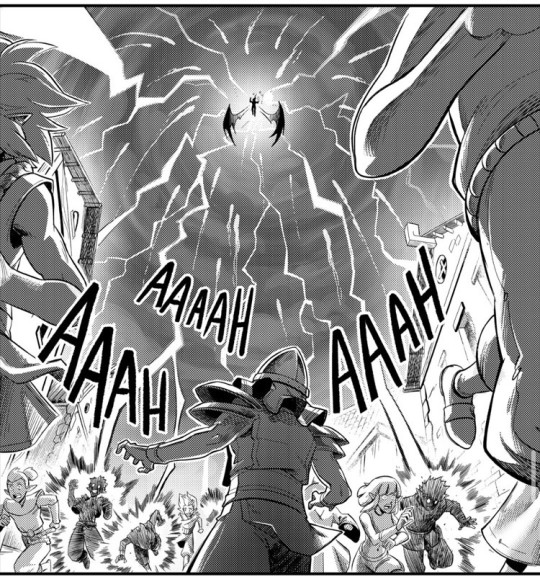
The only difference here however is that the dragon doesn’t seem to be nonchalant or even satisfied to steal their lives. He looks to be in misery at the idea of committing this action since we can see him shedding a tear at the lives he’s stealing. So we at least know he doesn’t entirely want to sacrifice a bunch of innocent people but for some reason has to.
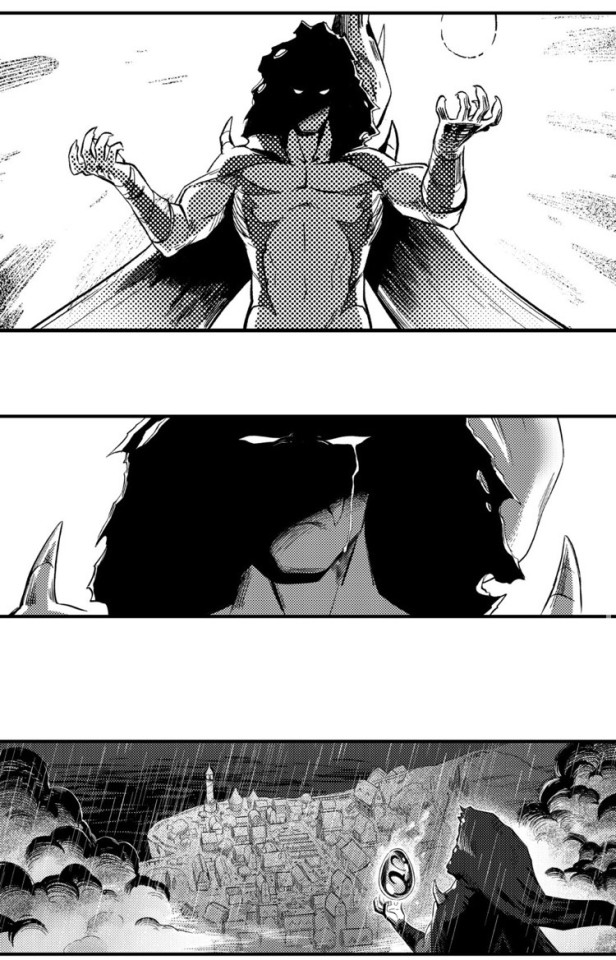
Julith discovered that in order to revive Jahash, exactly 1000 souls needed to be stolen. Her findings have revealed that one person is equivalent to 1000 souls. As the dragon aimed to revive only Julith, it is likely that he actually sacrificed at least 1000 people from this town, which had been thriving until now.
What’s also shocking about this whole ordeal is that the reason why he came to this specific village was because Julith’s body had literally been under the ground this whole time.
These people had unfortunately been unlucky enough to have settled their homes over her body which resulted in the dragon using them as the perfect sacrifices to revive her.
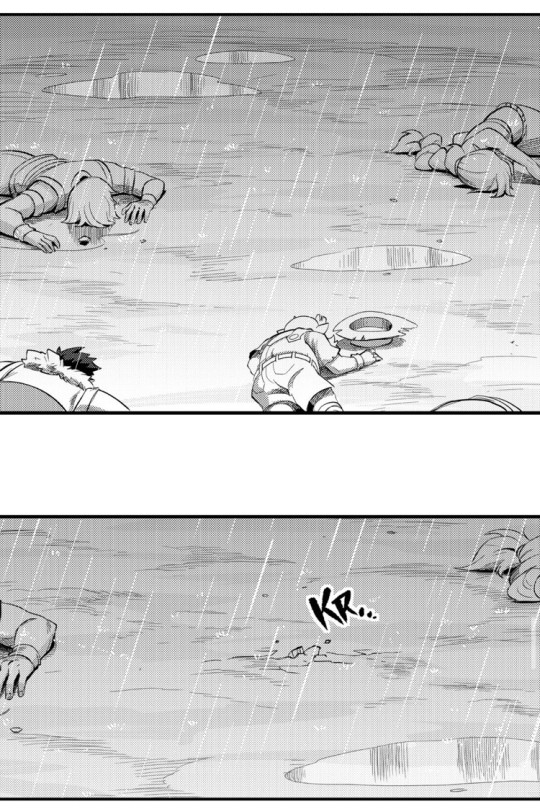
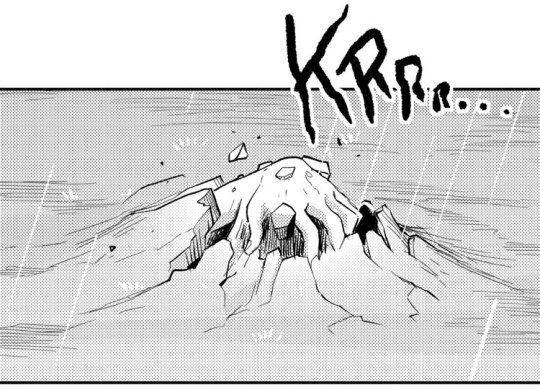
But why bring back Julith?
Would the dragon be hiring her for a job? Julith used to be the guardian of the Ebony dofus so the dragon somewhat had a reason to bring her back but why now then?
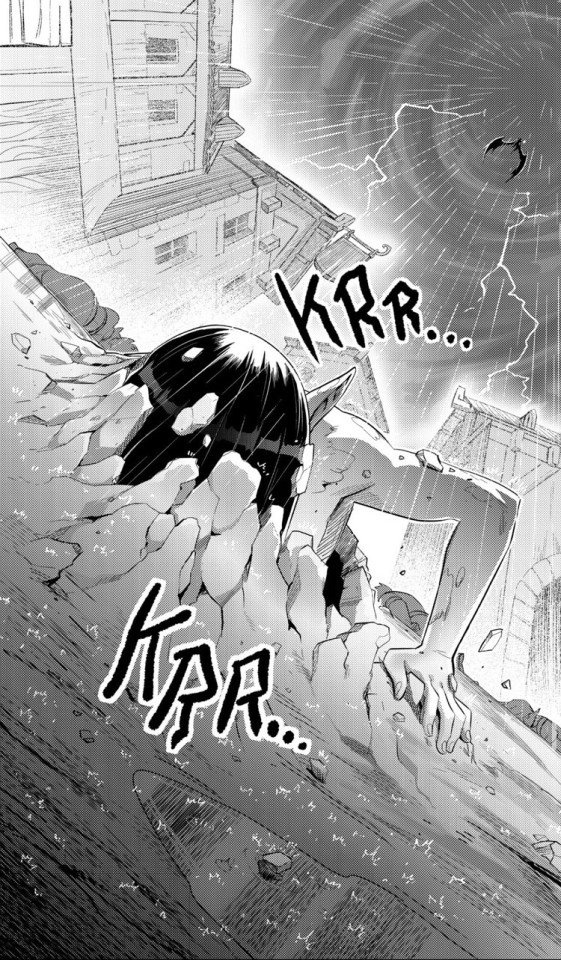
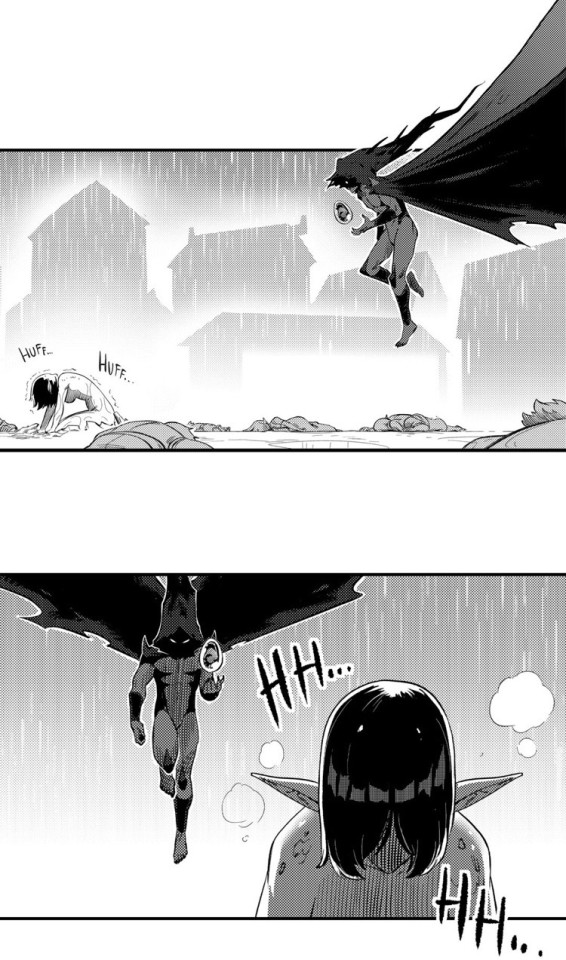
Would he use Julith to make her fight Yugo?
Is that what this is all about? Or is there more to it? Also, would Joris be in the later chapters or the next volume to see her again after all those centuries?
This chapter gave us so many questions and very few answers. Because now that we know what the dragon intended to do with the village, we now have to wonder what he plans to do with Julith.
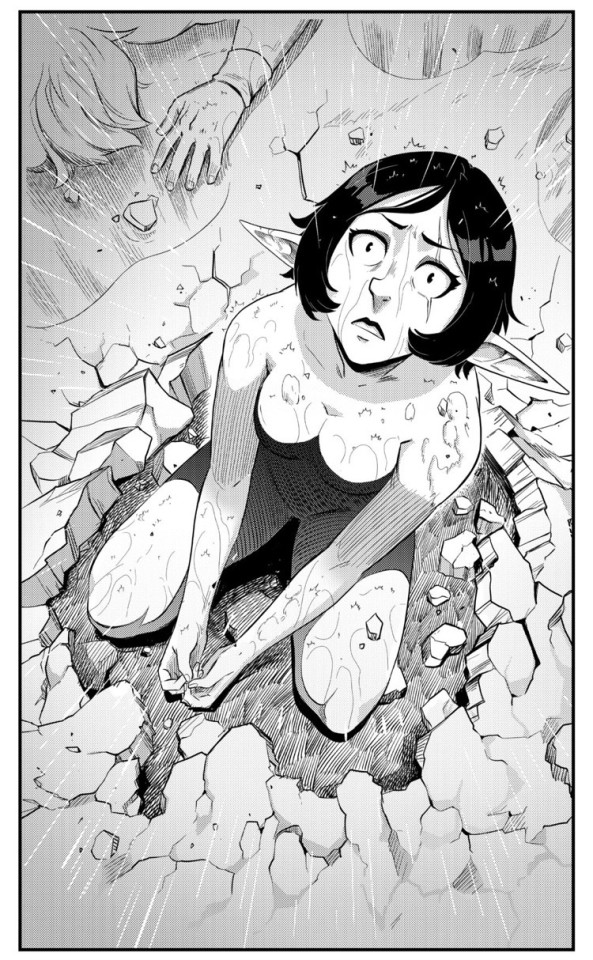
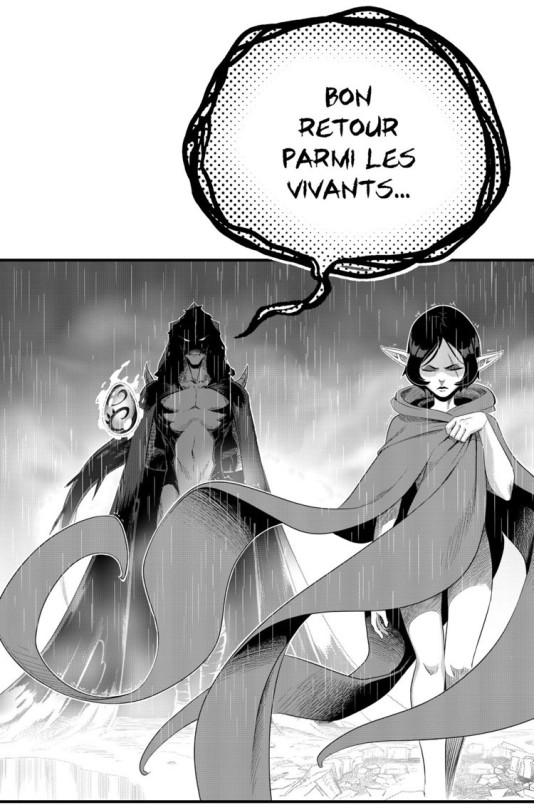
I don’t know about all of this but I do think it’s ironic that Julith got revived by the very same technique that she intended to use on Jahash only to refuse to go through the complete process at the last minute.
#wakfu#ankama#krosmoz#wakfu manga#wakfu webtoon#wakfu the great wave manga#wakfu the great wave#the great wave manga#the great wave#wakfu chapter 4#wakfu chapter 4 review#wakfu the great wave chapter 4 review#wakfu the great wave chapter 4 manga review#the great wave chapter 4#the great wave manga chapter 4#wakfu review#wakfu reviews#wakfu season 4#wakfu s4#wakfu season 5#wakfu s5
49 notes
·
View notes
Text
Doors To No Where Drop Rowdy Grunge-Punk-Desert Spinner ‘Darkness Falls’
~Doomed & Stoned Debuts~

Review by Billy Goate
Before us is the latest record from Santa Cruz heavies DOORS TO NO WHERE, a band new to these pages but which has played alongside many of our favorite West Coast acts, including KooK, Worship, and Year of the Cobra. As May is Mental Health Awareness month, it's good timing to be introduced to 'Darkness Falls' (2021). "This came to me during the pandemic," says frontman Marc Lewis. "I was watching so many folks struggling from all walks of life. Struggle isn’t biased -- it can hit anyone."
The album lyrically was a concept album in a way on the topic of mental health and its impact. I'm truly passionate about this and want it not to be such a taboo thing to talk about or seen as a sign of weakness.
Composed during the pandemic's most clutching moments and recorded with Aaron Cooper of Pylon Productions, the album features longtime collaborators Marc Lewis (guitar, vox), Marc Prefontaine (bass), and Pete Testorff (drums).
"Lie, Lie, Lie," dashes off to a furious Foo Fighters pace as we begin the record, with Pete Testorff's fervor and panache paving the way for Marc Lewis to deliver the three word chorus with all the snarl of a man who just wants to break his rusty chains and run.
"The riff in Lie, Lie, Lie," Marc tells Doomed & Stoned, "was written off something I heard Pete doing one night during sound check. He was playing his whole kit and then doing those snare hits you hear at the beginning of the song."
There's some nice give-and-take between Marc Lewis' guitar and Marc Prefontaine's bass that betwixt the introduction and chorus. I didn't pick it up at first listen, but it definitely grabbed me the next several spins through.
The grungy lyrics match the pissed-off spirit of the music, as the song mourns the loss of a common reference denominator for truth, warning that in its absence there is division, calamity, and ruin. "Together we rise, together we fall." Marc amplifies these powerful moments for us:
This track centers around the idea of false power and how someone could start to believe their own lies and self-hype, while others could fall for it. It can become a toxic relationship or even a cult kind of thing.

It may be hard to remember this far into this surreal "pause" in our world's history, but we too were afraid, alone, and angry for much of the pandemic's wake -- especially in those uncertain early moments when we followed the spread of this strange disease from China to Italy and onto the shores of Seattle and New York.
Darkness Falls by Doors To No Where
The aptly named "Fade" comes next, presenting at a doom's crawl with a sombre arpeggiated motif that summons the spirit of Trouble and Saint Vitus. Or you might hear a twisted, doomed-up variation of Metallica's "Enter The Sandman" in that low-end omen. "Fade was built of the rolling riff and bend," Marc explains. "I wanted it fat and raunchy." Certainly Pale Divine and Dirty Grave come to mind as I seek to match the mood with bands of similar spirit.
Then comes the pained chorus: "Run, run baby," which Marc illuminates in a very personal light:
"Fade" is about a friend of mine who is no longer with us. She was a larger than life personality that was loved by all. She played the personna and role of the happy-go-lucky person. She thought that's why people loved her and why they were friends. She was actually really struggling with mental health and depression though. She would behave in a way that she thought people wanted her to behave, while she was actually suffering. Those around her did not realize her pain or that their influence was making things worse. For years she would self-medicate with drugs and alcohol and that was celebrated by those around her.
I had started to see signs of her pain and tried to reach out. Unfortunately, I was too late. Any time anyone would reach out for help, she would disappear. The chorus line “disappearing one” is a reference to her pushing away and hiding from help. When she passed (sucide) everyone spoke of how special she was and how much they loved her. I was angry and sad. Why didn't more folks try and help her? My perspective was that coddling her addictions and self-medicated escape helped her to the grave.
The lyrics “We all love to see you fade, but don’t you go away” and “We all love to see you soar, but don’t you fade away” are references to the idea that sometimes humans are selfish in their relationships. Meaning that someone may give me the attention and things I need without me being aware of the sacrifices the other person is making.

"Worship The Machine" is another hefty doomer, with some wild guitar noodling contrasted against a rhythm that is quite machine-like as it dances stoically along its predestined chordal path. "Worship The Machine was written to be heavy and groovy," the band notes. "We wanted it to have a certain feel that pushed hard, while still having that chugging along kinda vibe." Closing in on the three-minute mark, Pete turns loose on the drums like a man possessed and the intensity continues when the rest of the band joins in, taking us right across the finish line to a crashing conclusion.
Darkness Falls by Doors To No Where
"I wanna live, but I'm dying" are words I can certainly relate to, not just in 2020, but in 2021, where the lingering impact of such a global (and personal) disruption is still very much a struggle on the daily. Turns out, my intuition was not far from the lyrical intent: "This song is all about the addiction to social media and how it corresponds with one's self esteem, mood, and self-worth. The social media world has become this giant machine and some are literally addicted to it. It creates this tool of status. I think it has truly impacted how people feel about themselves and others."
"Got Mine" is up next and this one is the most punkish track yet. It reminds me a lot of Soundgarden's periodic forays into punk, with songs like "Nazi Driver," "Never Named," and "Kickstand." On this point, Marc is clear: "Got Mine is influenced by the fact that I love old punk rock. I love the energy and the attitude. We wanted it to be loose but with tight stops and control." As to its meaning, we're told:
This song is about a revolution with the main character being selfish and self serving. So the character is done with the revolution or fight once their needs and wants are met. They are not really looking out for the cause or to tackle bigger issues for the good of humanity. They are actually looking for what is best for them. The chorus refers to a cold heart and lack of empathy.
Darkness Falls by Doors To No Where
All you lovers of southern sludge will dig "Policy" with its Goatsnake meets Acid Bath groove and sassy guitar lead. Speaking of Soundgarden, I really dig the Kim Thayilesque breakdown and stinging solo two-minutes in, though some may draw parallels with Crowbar here. These are all, of course, points of reference to try to do the near impossible: put the emotional experience of one listener (e.g. yours truly) into words. In the end, it's up to you to listen and find a favorite of your own. For my money, "Policy" is where it's at. Check out the fantastic dual guitar interplay two-and-a-half minutes in! Down, eat your heart out.
"Policy" is another riff I wrote to play off of a groove I heard Pete do during warm ups. It's got a swing to it but punches hard. Almost a heartbeat if you will. The solo was a direct result of playing the drums.
This track touches on letting toxic people go from your life. At what point do you stop investing in someone's negative energy? Fool me once, shame on you. Fool me twice, shame on me. It is the idea of surrounding yourself with people that want you to be the best version of yourself.
Up next: "Who Died", which summons all of the band's talents. Beginning with bursts of rapid-fire guitar picking set against a zombie-like beat and chorus, the song has something of a swampy feel. "I won't follow you!" Mr. Lewis shouts defiantly. I wasn't sure where the song would progress from there, and almost thought it was concluded at the false stop barely two-and-a-half minutes in. But the song rallies and the band pulls out its full force, with what sounds like the addition of the synth to present a layered effect that amplifies the intensity. I think this could have been developed even further, but sometimes brevity is the most appropriate option for a song.
"Who Died" was written off the chorus and intro. Zeppelin kinda riff. It's all about feel and giving the riffs room to breathe. This track is about the concept of thinking for yourself and not being an easy victim of mental or physical abuse.

The reverberating echoes of organ-sounding keyboards greet as "New Monster" takes its place next. We get our footing pretty quickly with a kind of "We Will Rock You" bass motif, but the song gets stranger and stranger as the seconds tick off. As with the previous track, there is a sudden atmospheric shift accompanied by furious strumming and ending on the swirling guitar theme we started with.
"Here we are, same ol' thing, round and round, 'ever again...I wanna run, I wanna breathe, I wanna live." This is, for me, perhaps the most relatable song on the record, lyrically speaking. This one especially gave off strong Prong vibes with its strong vocal lead, robust drumming, strong bass play, and industrial guitar feel.
"New Monster" was written in isolation and was originally an acoustic song. Even though the tempo is upbeat it's a dark and murky riff. We wanted the end out of the breakdown to hit hard. I imagine it building like a wave in the ocean.
Another track focusing on mental health with the idea of perseverance and to keep fighting, "New Monster" is the idea of not being perfect is actually perfect. We are all just floating on a giant rock in space and going through this thing called life together.
Darkness Falls by Doors To No Where
At last, we reach the record's namesake "Darkness Falls" -- the gem of this eight-pronged crown of thorns. I've always thought it was a great name. Darkness Falls is also the title of a 2003 movie about a malevolent tooth fairy, though I see no compelling reason to connect the film with either the song or record. I may not be too far off the mark, as Marc Lewis explains:
This concept came to me during the pandemic. I was watching so many folks struggling. All walks of life were struggling. Struggle isn’t biased and can hit anyone. “Please, please shine for me” and “Please, please glow again” reflect on how badly I wanted things to be better. For things to be ok. How I wanted those I love to be happy, safe and loved.
As it stands, Doors To No Where does a superior job of fleshing out the notion of "Darkness Falls" than previous contenders in any medium. The song stirs up a smokey, mysterious Near-Eastern ambience. Four minutes in and it's confirmed: there is indeed a synthesizer at play on Darkness Falls but its hypnotic effect in this song is interrupted by a screaming riffstorm and a gut full of churning bass. This song would make a great companion to "What The Hell Have I" by Alice in Chains. It also pairs well with Portland band A//TAR, whose metaphysical music we've also debuted in these pages.
"Darkness Falls" is special for another reason: Bob Balch of Fu Manchu and Big Scenic Nowhere was a guest on the album closer. "Him and I worked together on the track," Marc reflects. "He is a pro's pro and added so much to the vibe of the song. His playing and tone are phenomenal.
The new album Darkness Falls by Doors To No Where releases to the public on Friday, May 21st via Desert Records (pre-order here). This is its world premiere c/o Doomed and Stoned.
Give ear...
Doors To No Where · DARKNESS FALLS
Some Buzz
Featuring Marc Lewis (Guitars/Vocals), Pete Testorff (Drums) and Marc Prefontaine (Bass). Doors To No Where have been making music since 2010. Their sound is heavily influenced by Santa Cruz and the local beauty it offers along with the rich history of music. Doors To No Where have been called a stoner rock band but also touch on elements of punk, doom, metal and even grunge.
Growing up on a skateboard and surfing has played a huge part on the influences of the sounds Doors To No Where like to include.

The band has toured in and been honored to share the stage with bands like, Mondo Generator, Fatso Jetson, Fu Manchu, The Melvins and many more.
Doors To No Where will be releasing 'Darkness Falls' (2021) via Desert Records on May 21st 2021. The fourth studio album features eight tracks and a special guest appearance from Bob Balch (Fu Manchu). Staying true to their roots, 'Darkness Falls' is a combination of desert rock and punk influences. The band tracked and recorded the album in the unusual quarantine times of Covid-19.
Follow The Band
Get Their Music
#D&S Debuts#Doors To No Where#Santa Cruz#California#grunge#desert rock#punk rock#heavy metal#Desert Records#D&S Reviews#Doomed and Stoned
1 note
·
View note
Text
HPWU: A One Year Retrospective
Harry Potter: Wizards Unite turned one year old last month, and over the past year, it has improved a lot.
This review is looking at HPWU as a standalone game, devoid of the context of the book series, any views of its author, the movies and spinoffs, or any other media associated with the Harry Potter franchise. I have plenty of opinions thereof, but they are not directly relevant to my opinions of the game and how it functions.
The game at its core is not particularly inventive, and at the beginning of its first year, it mostly felt like a reskin of Pokemon Go. Spawns appear on the screen based on a map that a player traverses in real space, and players must tap on the spawns and then attempt to collect them in order to complete their collections. But instead of catching Pokemon to fill the Pokedex, players are rescuing “foundables” from “confoundables” to fill their stamp collections. Unlike Pokemon Go, multiple copies of each foundable must be collected in order to acquire the stamp, and once the entire page of stamps is collected, it can be prestiged in order to start the whole process over again.
Traversing the world, though, can prove to be complicated in anywhere but the most urban of areas. I live in an urban area, close to my local downtown, and at the game’s inception, I had to walk pretty far in order to complete my daily F2P chores each day. See, all of the POIs (points of interest) on the map are auto-generated from the data in Niantic’s original game, Ingress, and each POI is randomly assigned to one of three types. Inns, where players can acquire spell energy, are the most common. Next are greenhouses, where players can acquire potionmaking ingredients and occasionally, more spell energy. And the least common of these POIs is fortresses, which allow players to enter timed dungeons either by themselves or with other players to fight baddies and get prizes for their efforts.
The randomness of assigning each of these three types of POI is a real drag for many players. When the game was first released, I had two greenhouses and one fortress reasonably close to my home. This was enough to play the game, as greenhouses also occasionally awarded spell energy just like inns, except that the dailies explicitly required me to interact with two inns each day in order to get any premium currency. And as I mentioned, the assortment of POIs was completely random! Some players found themselves with nothing but fortresses around, while others had only inns and no fortresses for multiple kilometers. I considered myself relatively fortunate that I only had to walk 1 km to get to a nearby inn!
But unlike Pokemon Go, while the game encourages exploring, the core mechanics are not well suited to walking. In Go, a rare spawn can be easily subdued in 1-2 attempts, and curveballs are quick and easy to throw. In HPWU, the rarer the spawn, the more difficult it is to capture, and the more likely it is to run away. Foundables are captured by tracing patterns on the screen, and they all have a rather low acquisition rate, which means the rare ones are more likely to flee than to stay put unless the player pours consumable items into their capture. And even so, a player having to trace the same pattern multiple times just to capture a single spawn means that there is much more time standing in one place and less time walking. This is not an exercise game.
And this is one of the core flaws that has plagued Wizards Unite since its inception. It’s a clone of Pokemon Go, but every single mechanic that differs from Pokemon Go brings it further away from Go’s vision of an exercise game. Wizards Unite is an augmented reality exploration game, but it’s more about exploring a story and a setting than about racking up burned calories. This is especially apparent in limited-time events that encourage players to spend multiple hours standing still by the same POI, challenging hordes of enemies.
Monthly Community Day events aside, the regular cycle of in-game events was fun and engaging at first, but it quickly grew dull as players finished the main story quest and found the primary content of the game to be the fortnightly events. This is always a struggle for F2P games, especially games that rely on collections rather than PVP mechanics. The events weren’t even new content, merely recolored versions of content that already existed in the games, spawning much more frequently than other foundables and with featured spawn rates. What was fun in the game’s first few months had quickly become tedious, especially when the featured foundables had low catch rates.
Despite this stagnation, the game has changed over time, and many improvements have been made. The tonic for trace detection, a craftable potion that allows players to summon foundables to wherever they are, was long overdue when it was introduced into the game, allowing players who were less mobile to encounter more foundables when they had time to play. Inns and greenhouses were rebalanced so that inns in less urban areas dropped more spell energy, and greenhouses’ spell energy became guaranteed, rather than a 50% drop rate, which was an important improvement for areas with a low POI density and an active playerbase. Adventure Sync was added, which allows the game to track steps. (Unfortunately, this feature does not function well, as the steps counted toward daily tasks only begin after the player’s daily login bonus, and AdSync requires the game to have access to the player’s GPS while the game is closed, which drains phone battery in the background. Players who already have AdSync enabled for Pokemon Go will not notice much difference.)
The most significant overhaul, of course, came with the onset of coronavirus. In order to allow players to continue playing from their homes, the daily requirement to interact with inns was removed, and the Knight Bus, which allows players to remotely access fortress challenges and even engage with other players remotely, was implemented. I have found that the implementation of the Knight Bus almost single-handedly revived my interest in the game when I had grown completely bored of it, as it was a lot more fun to play fortress challenges with friends, which I had barely been able to do before, than to play the game solo.
But these improvements also serve to highlight the flaws in this game that have not been improved since its release. Trace completion always takes a particular shape, and its right-handed bias is clear the moment one attempts to complete a trace off-handed. The swirl of Ebublio, in particular, which takes an “e” shape, feels much more natural in the counter-clockwise direction in the right hand than in the left. Mirroring traces in a left-handed or “mirror” mode would be an easy fix!
SOS assignments have not been updated since day one of the game, and they have said “new assignments coming soon” since I completed them. In my first few months of playing, that was the real draw of the game for me, finishing the story quest and continuing on to the next page to see what would happen next. Each event feels like filler, while what would have made the most sense would have been to add four or five new pages of story quests every few months or so. And they (and all other events) aren’t replayable, so when WB/Niantic/whoever is responsible finally gets around to adding them, we’ll all have forgotten what happened. I already don’t remember.
Finally, the entire story as a whole, which is told as a haphazard, shoddy, zigzagging extra flavor to the repetitive, bland events, could have been told with just a week or even a day of gameplay in a regular game. “What is causing this calamity?” the characters ask. “I don’t know, but let’s patch the problem and investigate the cause later. Maybe the identity of the next problem that arises will give us a clue.” The game relies on half a dozen characters who show up just to give the player instructions, and it is somewhat over-reliant on the draw of the property to encourage players to invest themselves in the game. This is not good for a game that is mostly divorced from the primary story of its franchise. Assuming I knew nothing about Harry Potter or his universe before playing this game, and even if I do, there are way too many characters, and no documented point of reference for a player to look at for a reminder. The main characters seem to be Constance Pickering and Hermione Granger, with a splash of Harry Potter and a pinch of Ron Weasley thrown in. Their commentary doesn’t add much to my engagement because it’s the same mildly curious “I wonder what’s causing this” speculation we’ve had since the beginning.
Good stuff appears to be coming soon. The strongest aspect of the game is the ability to customize one’s character with an ability tree, which lends more variety to the way players can interact with the fortress challenges. An upcoming update is set to add this customization to the map screen, which may give this game the new life it so sorely needs.
All in all, judging Wizards Unite by its gameplay and content alone, and divorcing it from the source material, I’d rate it a C+. The game isn’t sure what it wants to be. It advertises itself as an exploration game, but punishes walking and rewards standing still. Adventure Sync once again rewards walking, this time when the game is closed, but the player is again punished, this time by severe battery drain. The game leans heavily on its story, but the story falls short due to poor updates and over-reliance on events to tease rather than deliver new story elements.
And of course, if we are to judge the game based primarily on its being an entry into the Harry Potter franchise, then we must begin to judge it on the merits and flaws of the franchise as a whole, which is a discussion for another day. If we don’t measure it against the franchise, there is much in the game that will be confusing to a player unfamiliar with the series. Who are these people, and why are we rescuing them? Why are we rescuing this one man some of the time, and attacking him other times? Four of the six pages of stamps feature characters from the franchise heavily. Players who aren’t invested in the franchise won’t care too much about them.
To someone who isn’t interested in the Harry Potter franchise, or to someone who was previously interested but has become disillusioned with the author of the series, I recommend you pass on this game. However, longtime fans who can still derive pleasure from the series, who separate the creator from the creation, or who view this and other derivative works as their own entries, created by teams rather than by the one who started it all, may enjoy this game.
1 note
·
View note
Text
Leftism poisons literature: Atwood’s Handmaiden’s Tale
I once lived in a harem ... the property of a polygamous Afghan family.
I once lived in a harem in Afghanistan—a harem simply means the "women's quarters." It is forbidden territory to all men who are not relatives. If you can't leave without permission or without a male escort, you are in a harem and living in purdah.
After a 30-month courtship, I married the glamorous, wealthy, very Westernized, foreign student whom I first met at college when I was 18. We never once discussed religion. Not a word about Islam. He had not prepared me for what life would be like in his country, even temporarily. For example, he had never even mentioned that his father had three wives and 21 children, that most Afghan women still wore burqas or heavy hijab, that I would be pressured to convert to Islam, and would have to live with my mother-in-law.
When we landed in Kabul, officials smoothly removed my American passport—which I never saw again. Suddenly, I was the citizen of no country and had no rights. I had become the property of a polygamous Afghan family. I was not allowed out without a male escort, a male driver, and a female relative as my chaperones.
This marriage had transported me back to the 10th Century and trapped me there without a passport back to the future.
Gilead's system of pseudo-theocratic totalitarian control in both her novels and in the MGM/Hulu versions does not accurately reflect what is happening in America today; it mirrors what is happening in most Islamic countries, a fact that Atwood and her admirers are too politically correct to notice.
Gilead Resembles an Islamic Theocracy, not Trump's America Phyllis Chesler
The Handmaid’s Tale is Margaret Atwood’s canonical 1985 novel of theocratic totalitarianism, spiked, along with other dystopian classics like George Orwell’s “1984.” Atwood’s book takes place in a world where a clique of Christian fundamentalists have overthrown the United States government and instituted the rigidly patriarchal Republic of Gilead. Environmental calamity has left many people infertile, and an unfortunate class of women who can have children, the Handmaids, are stripped of their identities and consigned to reproductive slavery for the elite.
It's become fashionable to draw comparisons between the popular television adaptation of Margaret Atwood's The Handmaid's Tale and Donald Trump's America.
Margaret Atwood, whose work I have long admired, is now being hailed as a prophet. It is quite the phenomenon. According to the pundits, Atwood's 1985 work, The Handmaid's Tale, which Mary McCarthy once savaged, and the recently-published 2019 sequel, The Testaments, are dystopias which aptly describe the contemporary climate change crisis, toxic environments, the rise in infertility, and the enslavement of women in Trump's America.
Is this all Atwood is writing about? Do the increasing restrictions on abortion in America parallel the extreme misogyny of Gilead, the theocratic state in Atwood's saga? Is the unjust separation of mothers and children, a la Trump on the southern border, what Atwood has foretold? Every review and interview with Atwood that I could find strongly insists that this is the case.
Michelle Goldberg, in the New York Times, attributes the current popularity of The Handmaid's Tale to Trump's ascendancy. She writes: "It's hardly surprising that in 2016 the book resonated—particularly women—stunned that a brazen misogynist, given to fascist rhetoric and backed by religious fundamentalists was taking power."
Gilead-inspired handmaid outfits have become popular at anti-Trump rallies as far away as Poland.
... At the anti-Trump pro-women's rights marches around the country, some feminist protesters dressed like Handmaids in billowing, shapeless red dresses, their facial identities obscured by large, white Victorian-era bonnets, carrying signs that read: "Make Margaret Atwood fiction again" and "The Handmaid's Tale is not an instruction manual."
They have a point. Abortion rights are being steadily challenged and nearly eviscerated in the formerly slave-owning American states. Right-to-life lawyers insist that the protection of unborn children without any gestational markers is the law of the land. We now have free states and slave states in terms of access to high quality, insurance-funded abortions. Pregnant, drug-addicted women are being jailed for child abuse.
Gilead most reflects what is happening not in America, but in most Islamic countries.
However ... [t]here's another contemporary parallel that also gets scant attention. Gilead's system of pseudo-theocratic totalitarian control in both her novels and in the MGM/Hulu versions does not accurately reflect what is happening in America today; it mirrors what is happening in most Islamic countries, a fact that Atwood and her admirers are too politically correct to notice.
Obscuring one's individual identity, masking one's face, sequestering women at home, may have been true of many previous cultures and regimes. However, in this day forced niqabs (face veils) and burqas (head, face, and body bags) are mainly realities for women in Muslim countries and communities in the West. In Iran in July, three women were sentenced to a total of 55 years between them for protesting against the veil.
In July 2019, an Iranian court sentenced Yasaman Aryani (left), Monireh Arabshahi (center), and Mojgan Keshavarz to a total of 55 years in prison for protesting against the veil. In The Handmaid's Tale Atwood does mention Islam twice (to exonerate Muslims as the suspected mass murderers of Congress, the Supreme Court, and the Oval Office in Gilead (p.174) and again in a reference to the "obsession with harems" on the part of allegedly Orientalist Western painters who did not understand that they were painting "boredom" (p.69). Atwood's quintessential Bad Guys are Caucasian, Bible-thumping, right wing, conservative, American Christians.
Where else but in the Islamic world do we see forced face veiling, forced child marriage, women confined to the home, polygamy (a "wife" and a "handmaid" under the same roof), male guardians and minders, cattle prod shocking, whipping, hand amputations, stoning, crazed vigilante mobs stomping and tearing people apart, and tortured corpses publicly displayed on city walls or hanging from cranes in order to terrify the populace? Or the torture murder of homosexuals? This is how Al-Qaeda, ISIS, Boko Haram, the Islamic Republics of Iran and Afghanistan, the tyrants of Somalia and Saudi Arabia, interpret, correctly or incorrectly, Sharia law.
How could all the reviewers not see what I so clearly see? Perhaps here's how.
A Kabul Bride's Tale
I once lived in a harem in Afghanistan—a harem simply means the "women's quarters." It is forbidden territory to all men who are not relatives. If you can't leave without permission or without a male escort, you are in a harem and living in purdah.
"I once lived in a harem ... the property of a polygamous Afghan family." After a 30-month courtship, I married the glamorous, wealthy, very Westernized, foreign student whom I first met at college when I was 18. We never once discussed religion. Not a word about Islam. He had not prepared me for what life would be like in his country, even temporarily. For example, he had never even mentioned that his father had three wives and 21 children, that most Afghan women still wore burqas or heavy hijab, that I would be pressured to convert to Islam, and would have to live with my mother-in-law.
When we landed in Kabul, officials smoothly removed my American passport—which I never saw again. Suddenly, I was the citizen of no country and had no rights. I had become the property of a polygamous Afghan family. I was not allowed out without a male escort, a male driver, and a female relative as my chaperones.
This marriage had transported me back to the 10th Century and trapped me there without a passport back to the future.
I experienced what it was like to live with people who were permanently afraid of what other people might think—even more so than in Small Mind Town, USA.
Read more about the author's captivity in Afghanistan in her acclaimed 2013 book.
I was terrified when I first saw women wearing ghostly burqas—ambulatory body bags, sensory deprivation isolation chambers—huddled together literally at the back of the bus. My Afghan family laughed at my over-reaction, which was considered abnormal, not their practice of burying women alive.
My dreamer-of-a husband kept assuring me that the dreadful burqa and my captivity would both soon pass. He lived to see this dream come true for about 15 years for the middle classes until it was shattered again, perhaps forever.
Many Afghan women have mothers-in-law who beat them and treat them as despised servants. Mine never hit me or ordered me to cook or clean, but she tried to convert me to Islam every single day and tried to kill me by telling the servants to stop boiling my water and washing my fruits and vegetables. I got deathly ill.
Poor woman, she was a deserted and much maligned first wife. She feared me, envied me, hated me—as a woman, an infidel, a Jew, an American, and mainly, as a "love match," something considered too dangerously Western. Afghan mothers-in-law do collaborate in or even perpetrate the honor/horror killings of their daughters and daughters-in-law. So do rural India-based Hindu mothers and mothers-in-law, Muslim mothers and mothers-in-law world-wide, and Sikhs, to a lesser extent.
I got out of the wild, wild East and I moved on. But I never forgot the way it was. I always understood that as imperfect as America and the West might be, it was still a much better place for women than the Islamic world. Forever after, I understood that barbaric customs are indigenous, not caused by foreign intervention; and that, like the West, Islam was also an imperial and colonial power, owned slaves, and engaged in gender and religious apartheid.
I owe Afghanistan a great deal for teaching me this. Perhaps my radical Western feminism was forged long ago in pampered purdah in Kabul.
The Real Face of Gilead
Islamic or Islamist totalitarianism today and as I knew it nearly 60 years ago in Kabul is the more obvious face of Gilead than the one imagined by Atwood more than 30 years ago.
Like the handmaids and domestics in Gilead, the captive population in Orwell's 1984 is monitored around the clock through "telescreens" that can view every room, each person. The telescreens broadcast Big Brother's orders and conduct daily "hate" sessions. People are always anxious and paranoid; everyone has permanent enemies.
Today, Orwell's Thought Police sound a lot like the Afghan Taliban or like Iran's or Saudi Arabia's Virtue and-Vice squads, who arrest men and women for the smallest sign of "individuality" or difference, and who harass and arrest women for showing a single strand of hair, or a glimpse of ankle. Here's Khaled Hosseini's fictional description of life in Afghanistan under the Soviets in The Kite Runner:
You couldn't trust anyone in Kabul anymore—for a fee or under threat, people told on each other, neighbor on neighbor, child on parent, brother on brother, servant on master, friend on friend...the rafiqs, the [Afghan] comrades, were everywhere and they'd split Kabul into two groups: those who eavesdropped and those who didn't...A casual remark to the tailor while getting fitted for a suit might land you in the dungeons of Poleh-charkhi...Even at the dinner table, in the privacy of their own home, people had to speak in a calculated manner—the rafiqs were in the classrooms too; they'd taught children to spy on their parents, what to listen for, whom to tell.
And here he is describing Afghanistan in the Taliban era:
In Kabul, fear is everywhere, in the streets, in the stadiums, in the markets, it is a part of our lives here...the savages who rule our watan [country] don't care about human decency. The other day, I accompanied Farzanajan to the bazaar to buy some potatoes and naan. She asked the vendor how much the potatoes cost, but he did not hear her, I think he had a deaf ear. So she asked louder and suddenly a young Talib ran over and hit her on the thighs with his wooden stick. He struck her so hard she fell down. He was screaming at her and cursing and saying the Ministry of Vice and Virtue does not allow women to speak loudly. She had a large purple bruise on her leg for days...If I fought, that dog would have surely put a bullet in me, and gladly!
Hosseini's descriptions are right out of 1984 or The Handmaid's Tale.
Two memoirs set in Iran, Azar Nafisi's best-selling Reading Lolita in Tehran and Roya Hakakian's Journey from the Land of No, describe the savage curtailment of private life and thought—and of life itself—by radical Islamists.
Two compelling accounts of life for women in Iran's Islamic Republic. According to Nafisi, Khomeini's goon squads closed newspapers and universities and arrested, tortured, and executed beloved teachers, prominent artists, intellectuals, and activists, including feminists, and thousands of other innocent and productive Muslims. The squads constantly harassed women on the street and at work. If a woman failed the dress-code standards even slightly, or by accident, she risked being arrested, probably raped, probably executed.
In Journey from the Land of No, Roya Hakakian describes the indescribable "Mrs. Moghadam," the newly-installed head of the Jewish girls' high school. Mrs. Moghadam tyrannizes, terrifies, and shames the Jewish girls. She tries to convert them to Islam. However, her true passion is more Talibanesque. She informs the innocent girls that, although they do not know it, they are "diabolical," "abominable," "loathsome," "lethal," capable of "drowning everything in eternal darkness," capable of bringing the "apocalypse" by showing a single strand of hair. To Hakakian's credit, she presents a rather dangerous turn of events as a dark comedy.
Mrs. Moghadam is definitely an Aunt Lydia, the lead female tormentor of the Handmaids, right out of Gilead, circa 1985.
Many Western feminists mistakenly see the face veil and head scarf as symbols of anti-racism.
As Muslim women are being tortured, honor-murdered by their families, or stoned to death, sometimes for refusing to wear the veil, many Western multiculturally and politically correct post-colonial feminists are deconstructing and wearing the face veil and the head scarf as symbols of anti-racism and as a form of respect when they visit Muslim countries. Such feminists are also silencing and demonizing all other views in academic journals, in the media, and on feminist internet groups.
I've written about this many times. Therefore, while I know that violence against women still remains a burning issue in the West, I agree with Allison Pearson's recent article in The Spectator: "The appalling vanity of Western Feminists who think Margaret Atwood writes about them."
Atwood depicts an all-female power structure in which the handmaids are kept in line by cruel female "Aunts," led by Aunt Lydia, who casually apply cattle prods and tasers, who blame them as evil sluts, punish them with group condemnation, bouts of solitary confinement, exile them to the "Colonies" to die cleaning up toxic waste, etc. Such behavior seems to contradict feminist views of women as morally superior to men and as more compassionate and intuitive.
Aunt Lydia (left) and the al-Khansa Brigade of ISIS Like men, women are human beings and as such are as close to the apes as to the angels. Women are also aggressive, cruel, competitive, envious, sometimes lethally so, but mainly toward other women. I would not want to be at the mercy of a female prison guard—or a female concentration camp guard—in the West. But let's not forget the Wives of ISIS—the all-female al-Khansaa Brigade who whipped, beat, and mutilated the breasts of girls and women when their heavy black burqas slipped. Displaced ISIS women continue their anti-woman reign of terror.
Misogynist thinking and actions exist in America today but not only among right-wing conservatives. It is also flourishing among our media and academic elites. Such thinking is flying high under the banner of "free speech," "multi-cultural relativism," "anti-racism," and "political correctness." Dare to question this elite's right to silence and shame those who challenge their views—i.e., that the West is always to blame, that jihadists are freedom-fighters, that the Islamic face veil is a free choice or a religious commandment, that polygamy encourages sisterhood, that Islam is a race, not a religious and political ideology—and, as I've noted many times, one is attacked as a racist, an Islamophobe, and a conservative, and swiftly demonized and de-platformed.
While MGM/Hulu's TV series is dramatically compelling, part soap opera, part horror movie, part Warrior Queen fantasy, the series is radically different from Atwood's 1985 novel. For example, Atwood's narrator, Ofglen, is not an increasingly daring, crazed, female assassin, as Elizabeth Moss brilliantly plays her. She is hardly heroic at all; under totalitarianism, heroism, collective or individual, is quickly ferreted out and destroyed. It exists but is rare.
Contemporary viewers are hungry for multi-racial characters, interracial and same-sex couples, "badass" women. Hulu gives them to us. Hulu's Canada is a multi-racial, politically correct refuge for Gilead's escapees; same-sex couples and feminists are government leaders. This is not true in the novel. On the contrary, in her 1985 Epilogue, Atwood has Canada rounding up and returning all Gilead escapees.
Media and academic elites are playing partisan politics with Atwood's original vision.
Atwood the divine novelist is absolutely entitled to depict whatever she wishes. But the current crop of reviewers as well as the filmmakers are playing partisan politics with her original vision and are refusing to see other and larger global dangers contained in her work.
Women's freedom and women's lives worldwide are under the most profound siege. To focus solely on the United States or on the Caucasian, Judeo-Christian West is diversionary. It scapegoats one country, one culture, for the far greater crimes of other countries and cultures.
Phyllis Chesler, a Shillman-Ginsburg Fellow at the Middle East Forum, is an emerita professor of psychology and women's studies and the author of eighteen books, including Women and Madness, Woman's Inhumanity to Woman, An American Bride in Kabul, and A Politically Incorrect Feminist.
Notes:
[1] Commercial surrogacy has been outlawed in India, Thailand, parts of Mexico, Malaysia, and South Africa, as well as in many European countries including Austria, Belgium, France, Ireland, Italy, Netherlands, and the UK. Hence, the campaign to legalize commercial surrogacy in America has gathered momentum.
[2] Contemporary surrogacy has now become a way of slicing and dicing biological motherhood into three parts: an egg donor, who undergoes painful and dangerous IVF procedures; a "gestational" mother who faces all the risks of pregnancy, childbirth, and potentially negative and lifelong medical and psychiatric consequences; and an adoptive mother or father. This vivisection of motherhood makes it impossible for a birthmother to win custody for any reason.
1 note
·
View note
Text
Maddie’s Big Gigantic Breath of the Wild Write-Up Where I Talk About Things I Like and Things I Didn’t Like
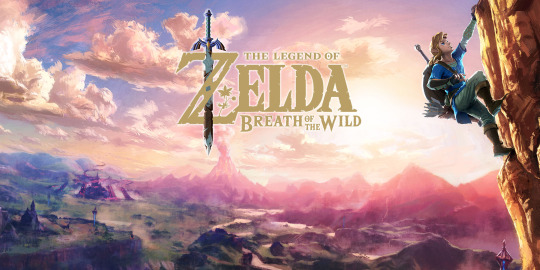
And regrettably, there are many things I did not like. But that doesn’t make this any less of a fantastic game that I enjoyed - I just wanted to put all my thoughts down in one spot. And yes, there’s spoilers.
--------------------------------------| Things I Like | ----------------------------------------
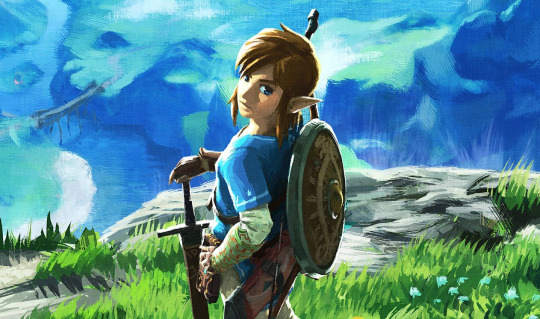
You can read any review for the game and that’s pretty much this section. There’s not much to say about the core game that hasn’t already been said, dozens and dozens of times, by professional or at least more knowledgeable game reviewers and critics out there.
Breath of the Wild (BOTW) is a big return to the uttermost classic Zelda feeling, of being a plucky hero in a big world that’s yours to traverse and discover, and get through on your wits and skills alone. But I’d actually argue that BOTW does the sense of open world and exploration far better than any other Zelda game comparison, not for the size of the maps (and man oh man they are big) but in that it gives you all the tools you need to explore within the first area and then kicks you out the door into the world. Any and all Zelda games, including the first, regardless of how “open” and non-linear you think they are, have a formula in that to progress through certain points, you must find an item that allows you to do so. BOTW dismisses that notion entirely and teaches you the core game mechanics and gives you the tools to explore wherever you want after the first area, and that’s a good thing. I spent the first several hours (upwards of a collective 20 or so) getting lost and just exploring, cooking food, finding side quests, fighting monsters, scaling mountains, and in a big way that’s sort of how the game is intended to be played. It’s full of creatures to hunt or befriend, hills to snowboard down on your shield, an expansive and hilarious physics engine to exploit, NPCs to meet and quests to be found and completed.

I like the provinces on the map, they’re either classic Zelda locations or call-backs to places from past games that weren’t always in Hyrule (large Majora’s Mask vibes, which makes sense, as this game takes place within the Child Era timeline). Even places that seemed the same at first ended up having subtle or severe differences, and of course the crisply-rendered graphics make the world vibrant, bright and inviting. While I miss the big orchestral scores I’m used to from other big console Zelda games, the subtle atmospheric music ended up being very nice and tonally appropriate, with familiar tunes sneaking in here and there in fun and sometimes beautiful ways.

NPC designs are unique, expressive, and full of character. Towns and hubs have a real sense of being lived in, with their own culture and way of life. Locations have their own passive dangers and benefits that make the world feel exciting and treacherous, and you can take any kind of approach to all kinds of situations. You can make special buff food or elixirs (one of the most fun things to do because I love watching the little food bits jump around in the pot) to brave the elements or give yourself extra bulk, or you can wear specialty armor or clothing, or do both. You can dye most outfits too, and tame and register your own horses and customize them. While a part of me misses the iconic green garb, being able to traverse Hyrule on a jet-black steed decked out in skulls and tattered leather while my Link was adorned with sleek black armor and cloak is kind of the best (and you can get the garb later, and then just build a custom green outfit yourself, which is how I went into end-game) Any weapon is fair game to wield as well, which was another part I greatly enjoyed and gave an added sense to exploration and that “get by on what you can find” survival aesthetic the game provides.

There really is a kind of subtle, almost accidental thoughtfulness to this game’s incarnation of Link. The background plot of the game describes, shows, and in some areas at least implies that Link was not a plucky hero from humble beginnings that the series is used to - Link was a prodigy in BOTW, a son of a proud and excellent knight who was to follow in his father’s footsteps to defend the kingdom and the royal family. Since he was a child he was groomed for this roll, despite the stress it caused him, until he became a trained and powerful warrior, even going so far as becoming the knight appointed to Princess Zelda, and wielding the Master Sword. He was the Hero from the beginning and was raised and trained his whole life to fulfill that role.
And he failed.
For all intents and purposes, Link in BOTW more or less dies (well, it’s implied he’s just unconscious and on the brink of death, but for my joking need to continue this “Link is the Chosen Undead” Dark Souls joke, yeah, he died). All the pomp and circumstance and careful, strict training surrounding his life ended up meaning nothing in the final grand scheme against Calamity Ganon. And this narrative carries not just to Link, but to the other cast of characters and Hyrule as a whole - years and years of careful planning and preparation was not what was needed to defeat Ganon.
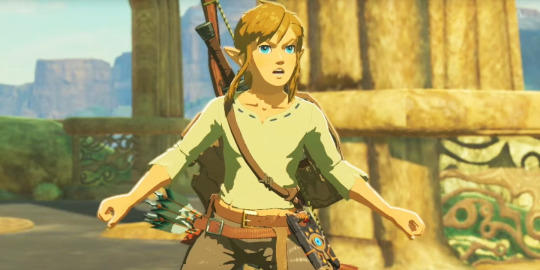
The game starts with Link being resurrected, with no memory of what happened 100 years ago and nothing to his name but a shirt and some shoes (and the Sheikah Slate I guess). But it’s this Link, stripped of everything, who has to cross the wilds and adventure, working his way up from scratch, completing test after test and trial after trial laid out by the ruined Hyrule and the ancient Sheikah sages in their shrines, who reclaims the Master Sword, earns the green garb (or doesn’t - you only get it if you complete all 120 shrines, which I think fits tonally because I wouldn’t exactly dub a guy who failed the first time a hero until he’s been thoroughly re-tempered for the task) and defeats Ganon. It’s not a bunch of strict, stately training given to a person who’s told their destiny from a young age and forced immediately to live up to it that makes a hero in Zelda games - it’s the plucky adventurer coming from little, courageously taking on feats bigger than them for the good of Hyrule and the people within it, working up to the final encounter.
Hyrule and the NPCs you meet echo that tone as well. It’s a world that’s had to pick up the pieces since Ganon re-emerged and laid waste to their world. Descendants and spiritual successors of champions from the past risking themselves for the good of their people, unprepared and outmatched compared to what they’re up against, but coming out on top with determination and follow-through in the end. The main story of BOTW has a bittersweet, but ultimately powerful and true-to-form Zelda tale that, on top of the immersion and pure fun the game provides is why it’s so easy to see why people have rated it so highly.
Unfortunately, extended playtime with this game revealed a ton of flaws and personal nitpicks, because despite what these scores claim, no game is perfect, and neither is BOTW.
----------------------------------| Things I Didn’t Like | -----------------------------------
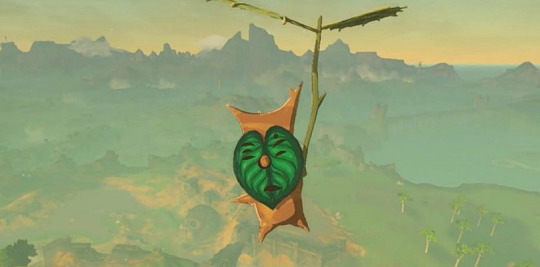
BOTW gets...repetitive, and at times annoying and even vacuous. I’d find a lot of really cool places during my exploration of Hyrule, but found that a lot of them just ended up being set-pieces to the world, with maybe a Korok hiding there (or maybe not, which was just super frustrating, climbing to a high mountain peak to find nothing up there). The game became measurably more enjoyable when I upgraded to full three stamina wheels, which took a lot of my early shrine upgrades to do, and that ugly, ugly little green wheel just constantly reminded me of how much I loathed it in Skyward Sword. I’d climb and climb and climb, usually not finding much of anything at the top later into the game. I’d find a set of interesting ruins, clear out the same enemies I’d fought 200 other times during the game, and not really find anything of interest within them. And god the enemies are repetitious. the same three core enemies in different colours, the same four or so core world bosses in different colours, the same Lynel and Guardians in different colours with ridiculous health bars that hit for 12 hearts a strike to impose the illusion of difficulty, when you end up just hitting them with ancient arrows, or using upgraded Stasis on them, or some other cheap trick because the combat and the difficult-to-time parrying and dodge/flurry attack prompts are not fun to activate (and if you fight them “properly”, especially the Lynels, get ready to run through all your resources).
When I go to a new area I want to see new enemies. Where are things like...I don’t know, Gibdos? Redeads? Poes? Darknuts? Skulltulas, Deku Babas, Gohmas, Armos, Dodongos, Aeralfos, Peahats, Likelikes SOMETHING ELSE besides these damn Lizalfos that keep JUMPING AROUND. I had one amazing encounter with a serpent dragon on an icy mountain peak, and had thought that I would have similar awesome encounters with the other two dragons in the game. Turns out the other two just sort of float around in locations and you don’t do anything with them except try to shoot them to farm items, no special encounters. Why.

I’d find a weapon I’d love but it would break quickly, so I ended up forming this habit of hoarding good weapons, bows, and shields, thinking I’d have to save them for later for fear they’d break, then ran into a problem where I was constantly getting showered in weaponry and had to play min-max on their attack numbers to decide what I was taking with me and what I wasn’t. I’d run into Koroks constantly to upgrade my storage space, but over time the malaise of searching for them after about 270 (out of a grand total of 900 Koroks) became too tedious and I stopped doing hyper-thorough canvasing of areas, especially because the canvasing didn’t really yield anything that exciting. I began, less and less, taking my horse places with me, because I could fast-travel and paraglide to locations I wanted to explore, and very often they were places I couldn’t even take my horse to. Armor variety, which I liked, ended up making a big chunk of food and elixir buffs superfluous and I no longer really felt a sense of danger or need to prepare for big exciting ventures into the bitter cold or so on. And upgrading armor ends up being a nightmare, as high-end stuff requires farming very precious materials, and if there’s one thing I did not like about Skyward Sword, it’s farming for materials.

Environmental hazards that could not be overridden with food or armor, particularly rain, halted my gameplay. I’d be trying to scale a cliff and, whoops - it was raining, which means you slip all the way down or exhaust your stamina trying to force through it. I’d have to go somewhere else and halt my progress on that spot, or attempt to find a place to make a fire and wait out the rain, which seems realistic in theory, but disrupts gameplay in practice. There’s also this weird abundance of cold areas in the game, but only really one hot area and only one “you’ll literally catch on fire here” area. A lot of shrine tests revolve around the same combat trial against the same enemy with a fluctuating health pool and do not get me started on the frustrating motion control mechanics for a few. I played the game on the Wii U as I did not want to get a Switch just yet, and suffered draw distance, framerate and even freezing issues. I figured this was an issue with the Wii U hardware, but hilariously it turns out this is an issue on the Switch as well (as an aside...it’s not really a good idea to have your flagship launch title with your new console be a game that the console can’t even run...)
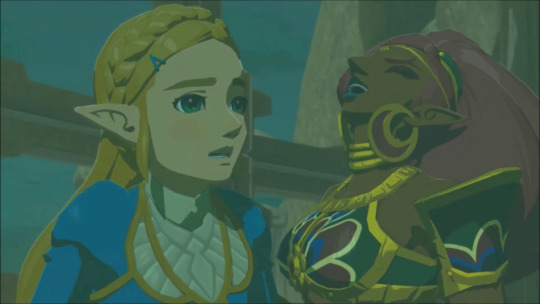
Then there was the story. I know I just talked a lot of good about it, but the thing is, the tones and storytelling I was talking about come across as...accidental, a sort of side-effect of the game as a whole. I don’t really play Zelda games for top-tier story - let’s be real, Zelda games do not necessarily provide enriching, unique narrative experiences. They are fun, generic adventure games with action-RPG elements, and that alone is enough to make them classics beloved by so many. But it’s been 25 years and the world of Zelda has expanded into a deep-reaching and ridiculous lore, enough that it has enough content to provide for a hard-cover art book, a historia featuring a collective timeline with three branching routes, and an upcoming encyclopedia. As years go by, narrative elements in Zelda games, such as story and character development, become larger and more prominent as the series develops. This is not a bad thing, and as a huge Zelda lore nerd myself it gives games a bit of extra appeal for me personally.
The issue with BOTW, and maybe the Zelda series as a whole, is that it’s kind of “blooming late” on the story and character narrative department in a generation where huge arcing epics with deep and relatable characters run regular in a lot of mainstream triple-A titles. BOTW, for example, is the first Zelda game to feature voice acting, something I was very wary about when I first heard about it, and ended up being rightfully wary. No it’s not terrible - the cast is doing the best they can with the stilted dialogue and passive direction they clearly had to work with, but it creates a very underwhelming and at times embarrassing experience that shouldn’t be so in a time when English dubbing/voice acting and localization is at some of it’s best (though not always of course), especially for a big-name title like Zelda from a big-name company like Nintendo. If this was the first time they were going to try voice-acting, this doesn’t really inspire me to look forward to it being a repeated trend in other titles. And even then, there’s actually only a handful of scenes that are actually voice-acted, with the rest of it being the usual textbox scrawls with some vocal sounds over top like in previous games, which begs the question as to why they bothered to go with the voice work at all.
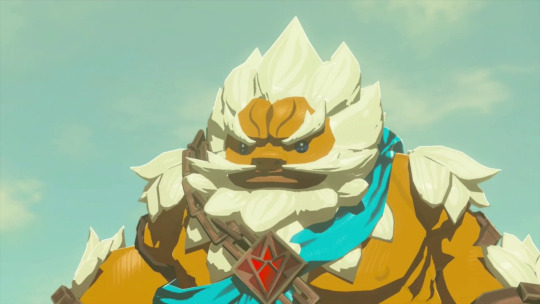
BOTW does something I refer to as A Plot and a B Plot, the A Plot being the main over-arching story of the game and the B Plot beside an over-arching side-story of the game. Typically, A Plots are the here-and-now of a form of media, it takes place in the present, with the B Plot being in the past, the future, or behind the scenes but being woven into the A Plot. When I set out to play BOTW, I thought that the failings of the past and it’s events would be the B Plot, with the A Plot as the here and now, focusing on new characters who would pick up the mantle of those who had fallen and see me into battle with Ganon. I thought I would follow the trials and tribulations of Princess Zelda in the A Plot, as well as the four champions, but it turns out, I was wrong.
When the game starts, the four champions are dead, and Princess Zelda is keeping Ganon trapped within Hyrule Castle, her power about to expend. At first I thought this was tonally appropriate - after all, they did fail, and it is supposed to paint a bleak picture of Hyrule. But this also meant that the only way for me to really learn or care about these characters was through optional flashbacks, and flashbacks are not really good tools to tell a story most of the time. I went and collected every memory, but didn’t really end up learning anything particularly new or exciting about any character other than Zelda herself - a wonderful character and incarnation of the classic princess, who is, honestly, a nerd. She’s an insecure scholar, burying herself in research to escape the stress of her failed ability to use her magic (Triforce, Light Force, I don’t know - the Triforce doesn’t feature at all in the game), the loss of her mother, and her honestly mean and scornful father and the doubtful whispers of her kingdom. She’s in over her head, and while her abilities and passion are best suited for studying the ancient technology and the Divine Beasts, at every turn it seems that she is forced away from this and told to focus on her destiny, that of using her sealing power to trap Ganon away. It plays again on that theme that pre-conceived notions and strict preparation in the name of prophecy and destiny and what have you still lead to failure, and that it’s through the heart of adventure and discovery that heroes that can defeat the darkness are forged. I expected that new champions would rise to replace the failed ones of the past, born from the adventure and sudden struggle of Ganon suddenly re-emerging, without any preparation beforehand. I expected Zelda to get her big moment where she proves that she doesn’t need old rituals and prayers to unlock her power, and that her inner strength comes from her true passions, and uses her research and scholar prowess to find ways to balk Ganon and use her power. I expected new heroes to rise and take control of the Divine Beasts in the steed of the failed champions of the past.
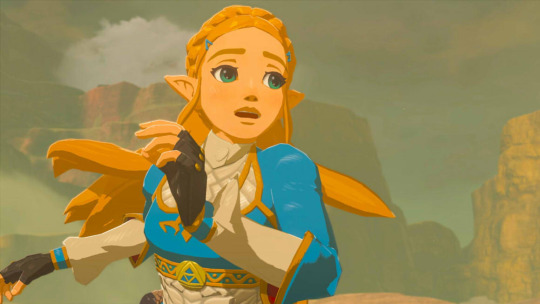
Well that doesn’t happen. The Divine Beasts get piloted by the ghosts of the fallen champions, who are ultimately dull and kind of not really likeable save maybe one or two. The new characters who help you get onto the Divine Beasts, which act as the “main” dungeons in the game, fall to the wayside and are forgotten after, apparently unable to become champions themselves (as only “champions” can board the beasts, apparently) despite the trials they face to assist Link and fight back against Ganon to save their people. The main dungeons lose their luster quickly too - they’re puzzle-based, requiring the same mechanic for each one (find five terminals, beat the boss at the end, each boss looks kind of the same). Something I thought was interesting was that each beast can be controlled from within, and you use that mechanic to solve puzzles. Two of the beasts end up using the same tilt mechanic though, and three beasts require shooting arrows at it to board (two of which are bomb arrows), and with the beasts’ interiors all looking the same it just sort of gets...a bit dull after a while. Been there, done that, done this, again. I really do miss more classic Zelda dungeons if just for the cheese factor, but this game does not have them.
Since the game has to use flashbacks instead of a continuous story to show the development and relationships of the characters (where dialogue is delivered unnaturally), the original four champions seem very one-note, defined by maybe one or two traits. The case of Revali is especially frustrating. Why is he so mean to Link? Is it his pride, did something occur between them, is it something else? We don’t know, we never learn, because primary characters introduced are not developed, he’s Just The Rival character, to fulfill the trope. His introduction in a mandatory flashback comes from Link literally looking at a bunch of planks of wood on a flight landing (I’m serious), and Revali is more or less an arrogant jerk to the end because That’s His Character I suppose. While we’re on the subject, the entirety of Rito Village is a wash - NPCs talk about how there’s nothing to do there, the Divine Beast is not causing any serious harm, it’s just not letting the Rito fly as high as they like and is being a general nuisance, the Rito that helps you board is just Some Guy and you don’t really see him again unless you want to do yet another optional and inconsequential mini-game. The dungeon is easy, borrows a boarding scenario from another beast, and borrows its in-dungeon mechanic from another beast. The whole area is such a let-down.
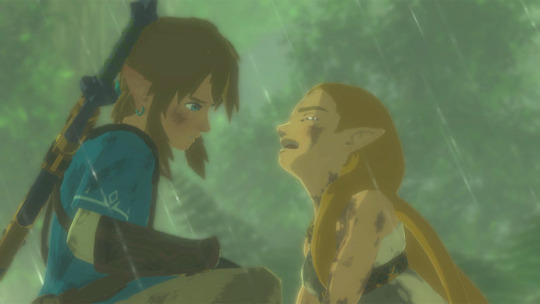
And then there’s Zelda, my poor, poor Zelda. She fails, just as everyone does, and I thought, and hoped, and prayed, just as I said before, that her inner strength would come through in the form of doing things HER way, using her research and her smarts, sticking it to the father and the people who didn’t believe in her by succeeding with the very methods they disapproved of. Well no - she activates her sealing power at the last second to protect Link because she loves him. It’s “tru wuv” that sparks her big character moment, where she does exactly what destiny pre-determined she do, not some awesome defiant moment where she pools her strength and self-confidence through her research and herself. She doesn’t even get to research and discover for herself that the power is apparently so closely linked to her “heart” or whatever generic nonsense works the magic this time - gotta love The Boy, that’s what makes you strong. And this is not extrapolating - when you complete all the shrine quests Kass the Rito bard gives, you can see him at Rito Village, where he tells the story of his teacher and the events just before the Calamity, and how his teacher fell in love with the princess, but the princess was in love with her appointed knight. The song his teacher taught to Kass after his teacher witnessed Zelda unlocking her powers was how her love for her knight was what brought it to the surface. Even the Zora champion Mipha, who I guess was supposed to be some callback to Rito from Ocarina of Time in a way, hints that her amazing healing ability is born by “thinking about who she cares about most”, and that’s not her family or friends or anything, that’s Link - who she loves and adores and wants to marry because that’s the Rito callback I guess.
I was so angry, it’s trite and tropey and ruins half the tone the game manages to do so well. Show me a BOTW Zelda who overcomes after failure not through “true love” and all the pre-destined nonsense that lead them all to failure to begin with, but the scholar she is using her research, her passion for knowledge, her wisdom, to unlock her power, to stop the Guardians, to seal Ganon.
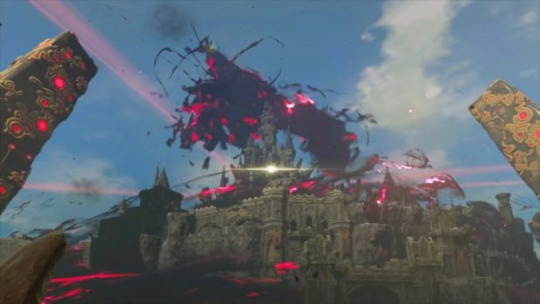
Oh and then there’s Ganon. “Calamity Ganon”, now a non-character - just an amorphous, shadowy entity of no real interest. I suppose you could say that after the events of Twilight Princess or Four Swords, Ganon(dorf) is really no more, no longer a proper physical entity, no longer the Gerudo man who had ambitions or menace or a tangible presence when he entered a room - that person was long since defeated properly, and it’s only the lingering malice, that sort of twisted essence of the primordial Demise from Skyward Sword, that remains. From a lore perspective that works, but it doesn’t make for an interesting villain, just like flashbacks don’t make for interesting storytelling and character development. The final battle in and of itself is hugely underwhelming too. Calamity Ganon’s first form is an apparently “incomplete” gooey, robotic spider...thing...it’s very ugly as a design in a game that’s had largely strong character and enemy designs, except for the Divine Beast bosses which, I guess fits tonally. And unlike other enemies where you can kind of take multiple approaches to the battle, you MUST bounce the laser beams in the second half of the fight back at the boss with either a shield parry or the Master Sword, which I think is the game trying to do the old “tennis mechanic” callback but it’s really...kind of janky and often unresponsive? The second form LOOKED much cooler and more tonally appropriate, with a huge, flaming Dark Beast out in Hyrule Field that I’d ride around on my trusty steed fighting. But instead Dark Beast Ganon just faces one direction only, shooting lasers at nothing. Your horse sort of meanders around and you just ride updrafts or stand safely beside it waiting for Zelda to shout very loudly and clearly about the GIANT GLOWING TRIFORCE-SHAPED WEAK POINTS you can hit with your Light Arrows - it’s all an exact, even easier version of all the “boarding the Divine Beast” scenarios you did earlier in the game.
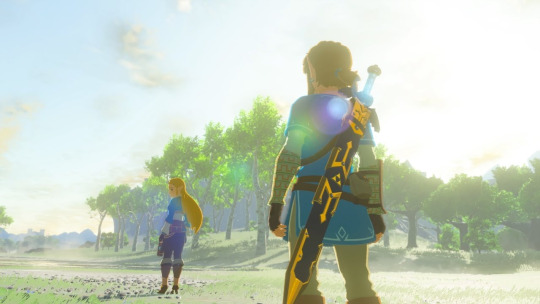
Zelda re-appears, seals Ganon, gives these really wishy-washy smiles and lines. The ghosts of the king and the Champions linger in the silhouette of Hyrule Castle and say nothing. We get no closure on the king and Zelda, who as far as the game wishes to imply in flashbacks and a hidden diary the king left in the castle, parted on extremely tense and unfavorable terms. the Champions get no final word in either. Zelda is shown after the credits kind of just...acting like everything’s a bit “back to normal”, saying her and Link need to go to Zora’s Domain to give the king closure on Mipha which...it’s been 100 years he’s...more or less made peace with the death of his daughter by now as was shown earlier in the game. Zelda says she can no longer hear the “voice” in the Master Sword and admits her powers must have weakened over the course of 100 years, but she’s actually okay with that for once, which I think would have been a bit more powerful of a statement to her character if she’d previously shown that her own determination and smarts were her true strengths all along, and not this HUGELY powerful magic. There’s a shot of the Silent Princess flower at the end, a flower that in the game Zelda comments on, saying that it cannot bloom in captivity and only in the wilds. Again, it would be a very thematically-appropriate metaphor for how Zelda’s true strength came from her journeys in the wild, focusing on her unique strengths and not those pre-determined by her destiny, but the game has her...literally in a state of “captivity” holding Ganon back. If anything the Silent Princess flower metaphor makes a stronger thematic statement for Link, not Zelda, and that’s really telling about how inconsistent and weak a lot of the story-telling is in this game. It was clearly supposed to really be about the relationship between Link and Zelda and their character development, but since they spend the entire game separated and only show shallow interactions of them together in short flashbacks that only really serve to develop Zelda (as well as her diary entries found in the castle), things end up feeling...vapid, forced and ultimately weak.
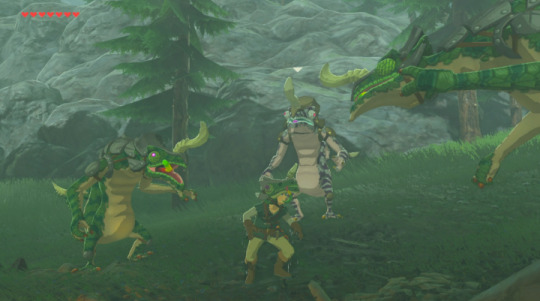
And I just...want to fight. A Darknut. One damn Darknut and have a cool sword fight. Or a Poe. Not another dAMN LIZALFOS. LET ME CLIMB TO THE TOP OF A MOUNTAIN AND FIND A WHOLE DUNGEON UP THERE.
I MISS.
HEART PIECES. AND UPGRADES.
AS REWARDS FOR EXCELLENT COMPLETION OF MINI-GAMES. IT INCITES. YOU TO REPLAY THEM.
AAAAAAAAAAAHHHHHHHHHHHHHHHHHHHHH
In summary, Breath of the Wild is excellent. But I’m a huge nerd and it’s clear that a lot of people who reviewed this game only went in for about 20 or so hours and didn’t complete it before passing final verdict. I hope Nintendo builds from this game’s strengths and learns it’s weaknesses.
35 notes
·
View notes
Text
Tales of Zestiria - Post Game Thoughts
(Or, I Ramble For Far Too Long About My Feelings And Theories Concerning This Beautiful Game)
Topics:
Introduction
Gameplay (graphics, systems, all that technical jazz)
Plot
Sidequests
Characters
Character Relationships
Music
Other Media (Anime, Manga, Novel)
In Conclusion
Introduction
Last night, I finally sat down and defeated the final boss in Tales of Zestiria. Needless to say, I had a lot of thoughts after witnessing the ending. Even after having written this monster of a post, I still have thoughts which have gone unwritten. This is just a few of the things I have to say about this game.
For a quick general review, though: 4.5/5 stars. A great story (albeit slightly rushed) with amazing characters and a beautiful gameplay and soundtrack. Even if you’re new to the Tales Of series, I’d recommend you to play this game.
Now, onto the meat of this post. I’ve tried to avoid spoilers as much as possible, and I’ve marked where I talk explicitly about spoilerific subjects. Still, be on your guard a bit.
Gameplay
Right off the bat, this game is beautiful. Having come from playing Tales of Vesperia (a 2007 game with good graphics which are nothing in comparison to TOZ) and Tales of the Abyss (which I’m still in progress with and switching between TOZ and TOA is always pretty jarring), I could not help but marvel at the graphics at every point during the game. The 3DCG animation is fluid and natural – in conversation, the characters have quirks which make them seem more realistic, something which I felt the aforementioned games lacked (not for lack of trying). The 2D anime cutscenes were also stunning, though I felt some were not particularly memorable.
The overall aesthetic of the game is also gorgeous – something I feel the Tales of series does particularly well in general. The character designs are gorgeous, especially for the main cast (though I feel this is a given). The towns are beautiful. Some of the scenery is downright stunning. I’m not an artist or designer, so unfortunately I’m not to grips with technical terminology or criticism, but that doesn’t stop me from drawing breath every time something caught my eye.
The system itself I found mostly easy to understand. The menu is akin to the other Tales games I’ve played, and I found map actions easy enough to understand. (My immediate reaction was that it was similar to the Sorcerer’s Ring in TOV, for a while.) I sometimes found having a secondary character running after me a bit annoying (Rose, this corridor is tiny and you’re blocking the door, please move- oh, fuck, a hellion). For the most part though, being able to speak to the secondary character and get hints about both the main story and sidequests was a godsend.
The battle system, though different from those in TOV and TOA, was in my opinion improved on in this game. I enjoyed having different kinds of artes to play around with, though telling the difference between the three was sometimes tedious. I also liked how easy it was to switch between melee attacks and hidden artes. Also backstepping and sidestepping became so useful in boss battles, particularly towards the end once I got to grips with it.
What I found more tedious was the skills system – I’m sure it will be less so once I get to grips with it, but having a skill tree with different combination options is something that might take me a while to wrap my head around. I also still haven’t ventured near the ‘forge arms’ option in stores, because I’ve heard that’s to do with skills and honestly I still don’t understand them enough to want to do that yet.
Though I do appreciate the ways in which the game gives you tutorials – not through a tedious tutorial battle, like in TOV, but through monoliths (which were fun to find and read, even if I wouldn’t normally have bothered reading the contents of them) and skits (which at least tried to make them sound interesting).
I also appreciated the game’s switching between battles and puzzles for dungeons. It really instilled a sense of, the answer to everything isn’t just beating it up, even when I used Edna’s map action (which seemed like beating up walls and rocks). And though some of the puzzles might have been a little tedious (*cough* water shrine *cough*), once I figured out how to get around the puzzles, it became really interesting to me. Yes, even for the water shrine.
(On that note, is it just me or was the wind shrine really easy? Like, easier than the others, I mean.)
Plot
The plot of Zestiria, in my opinion, was mostly well done. It follows the journey of Sorey and his friends as he becomes the Shepherd and fights in order to free the world from malevolence, with a focus on defeating Heldalf, the Lord of Calamity.
*** The following paragraph contains massive spoilers. ***
To be completely honest, the plot did feel a little rushed, at times. Even when I got to the final dungeon, I had to check it was definitely the final battle, because it felt like there should have been more. After all, we didn’t get so much resolution on Maotelus’ history or future (though I suppose much of it was up to interpretation). I also kept thinking that there had to be another way of ending it all, especially since in the beginning, Sorey resolved within the main plot to help Edna to purify her brother, but that isn’t addressed in the main plot at all after that point.
In the end, though I had wanted a different ending, I understand that this might be reflection of what the story is trying to tell us. Not all endings are peaches and cream happy fun times. Something has to be sacrificed in order to gain a good outcome, and not all people – humans or seraphim – necessarily believe that what the Shepherd is doing is for the best. (For that reason, Symmone’s story was really interesting for me, though she had more potential than what was utilised.)
So after some consideration, I feel that they ended the game in the best way they could have done for the story that it’s trying to tell. Even if it wasn’t the most positive and happy-ending kind of story, there still is a positive in the future.
(Again, I feel that’s something the Tales games do well – illustrating the multiple facets of a situation, how any solution has consequences, both good and bad. Not everyone will agree, and not everything will be solved, but when the root of the problem has been fixed, that is where the story ends for us, even if it goes on for them.)
*** Spoilers end here. ***
Some points of the plot also felt rather tedious – purify the malevolence here, find the iris gems there, go to and from Glaivend Basin about ten different times. Still, the story behind the plot is strong enough to make an interesting game. It has certainly made me interested in the lore behind the Shepherd and the history of that world as well as the future of it.
(On that note, is Glenwood the only continent mentioned in the game, or is it just me? How do you save the world by travelling over one continent? Are you just saving that continent from malevolence?)
Sidequests
Despite the fact that I’m glad so much of the story was told through the main plot, I feel that sidequests were somewhat lacking. I think it’s because I’m so used to Tales of Vesperia, which has a gazillion sidequests (which I’m almost finished completely! The fact that it’s taken me five years to get close to 100% completion is definitely saying something). Since this was only my first playthrough, I haven’t thought much about the sidequests. I’ll come back to this when I’ve done more of them.
(Sidenote: The turtlez sidequest made my entire life.)
Characters
Sorey
Sorey, my boy. My sunshine child. Can I just wrap him up and protect him from the world?
I love Sorey so much (if you couldn’t already tell). He’s an innocent, sheltered boy, having lived in the remote Elysia alongside seraphim for all his life. And yet he is filled with a passion and charisma and general optimism, especially when it comes to things like ruins (I love his history nerd side so much, but maybe that’s because I’m interested in history too). He has a definite hero complex (and perhaps a martyr complex?) which feels like a main part of the plot – the fact that he wants to save everyone, to see everyone living in peace and harmony together, and the fact that in this world filled with malevolence, it seems unlikely to ever happen.
Some people might feel that Sorey is too vanilla for them, considering his hero complex and naivety, but in my opinion there is a lot more depth to his character when you consider the hardships he has to go through, particularly towards the end of the game.
Mikleo
I loved this boy even before I played the game. I knew nothing of his character, but his general aesthetic pleased me greatly. The game did not disappoint. Mikleo is a stubborn but kind seraph, one who relies heavily on logic and analysis to think through situations. For that reason, he loves ruins just as much as Sorey, particularly trying to analyse them and to see how things work and what the reasons for certain things might be. (I’m not kidding, a skit about matryoshka dolls is what triggered me to find this interesting.)
His character depth and development is beautiful, especially when you consider his fears in the beginning of the game (not wanting to be a burden to Sorey, but not wanting to be left behind, with the knowledge that he will age much more slowly than Sorey and will certainly end up outliving him). Though he is still a bit of a kid (that much is obvious in how he rises up to Edna’s teasing), he is still rather mature and eloquent.
Alisha
I can see where the controversy comes from, surrounding Alisha. The advertising for the game made it seem as though she was the main female character assisting Sorey, but she ends up leaving the party for the majority of the game. Still, I think Alisha was a well-written character and an interesting contrast to her successor, Rose.
Alisha is a strong-hearted, optimistic girl who wants to serve her kingdom in whatever way she can. Like Sorey, she believes in the Shepherd and the seraphim and wants to see the world rid of malevolence. The only trouble is that Alisha’s resonance, whilst stronger than most humans’, is still not quite up to par, making it difficult for her to assist Sorey as his Squire.
In my opinion, I felt this was an interesting character flaw. It gave depth both to her and to Sorey, considering the effects of it on the both of them as time goes on. Even though many might have been disappointed that she could not armatize in-game due to her lack of resonance, I felt it befitting of her character.
I’ve not played her DLC yet, but I still enjoy her character very much and think her development throughout the game was strongly written, even if it was mostly in the background.
Lailah
I love Lailah so much. As the guardian type of character, she has the most knowledge – and yet, she cannot pass on much of it due to an oath restricting her from it. This, I feel, is a huge part of what makes one of the main plot themes, ‘finding the answers’. (I’ll talk about that later, though.)
Lailah is a cheerful but conscientious character. She has experienced being a Prime Lord for a Shepherd before, and knows about the truth behind the Dawn of the Age of Chaos. Her inability to speak about it makes her rather mysterious (though I enjoy her whimsical methods of avoiding the subject). Outside of her role as a Prime Lord, Lailah is a humorous and almost motherly character (though she’d rather you call her ‘big sister’, thanks). She cracks puns and jokes quite often, much to the chagrin of her friends.
I also enjoy the development she goes through and her subtle way of realising that she doesn’t have to carry her burden all on her own, either. (The Lailah and Rose conversation before the final battle makes this all the more poignant, in my opinion.)
Edna
I will fight for Edna. I love Edna. Protect Edna 2K17.
Seriously, though, Edna is wonderful. She is a sassy, sarcastic character with a troubled past and present (particularly familial). She enjoys poking fun at the more gullible characters, particularly Mikleo (or Meebo, as she calls him).
Her development is also beautifully done, particularly in the sidequest concerning the dragon at Rayfalke Spiritcrest. Though she is reluctant at the beginning of the game, we see her opening up to her companions and fighting alongside them for their cause. I might have liked to see more development for her in the main plot, though I feel the sidequests did her justice enough.
Rose
I love Rose.
By day, she’s a cheerful merchant, always shaking the hand of capitalism in search of a deal. By night, she becomes an assassin, gracing weary bones with peaceful rest. And her dual personality is only the top layer of her character – it doesn’t even scrape the surface of her past.
(This is something I feel particularly in regards to the anime, though I’ll speak about that later.)
I love that Rose acts as Sorey’s foil – the dark to his light, in a sense, though they fight for the same cause and are both of pure heart. She is just as selfless and forgiving as he is, though her way of solving problems is different from Sorey’s. (Is anyone else getting flashbacks to Flynn and Yuri? One seeks justice through what is morally right, the other through murder…)
Her reluctance to accept the existence of seraphim also intrigued me and gave her role as Sorey’s second squire an interesting twist. I also love how she develops, eventually accepting and embracing the seraphim, and being grateful for their presence around her.
Dezel
(Brb, currently weeping softly.)
Dezel grated on me a bit at first, mostly because of how he acts when we first meet him. And to be honest, for most of his role in the game, he is the same way, though obviously he does have some development which helps towards his major change of thinking in his final scene. His backstory greatly intrigued me and through it, you can certainly tell that he is only young, and hence gets easily riled up. Any mention/indication of him after That One Scene made me want to cry. His redemption truly was well done. I would have liked to see more of him.
Zaveid
This man needs to be stopped. Stop Zaveid 2K17.
(I’m joking, but still.)
I love Zaveid. He reminds me a lot of TOV’s Raven – kind of a comic relief in his commentaries, particularly concerning ladyfolk, but with a depth of character hidden behind that mask. I did feel that his entrance to the party was a little rushed (they could have given us a little time to grieve, dammit), but other than that I enjoyed playing as him. I feel like his development was a little less obvious because of the façade he keeps up, as well as his status as a semi-antagonist in the beginning, but in general, he was well written and interesting.
Character Relationships
In general, I love the relationships between the characters. I love that the game places no emphasis on romance and tonnes of it on the platonic bonds between our main cast, and how they work together and support each other. By the end of the game, they felt like a real family, which brought back fond memories of TOV for me.
For now, I’m only going to go into depth on one relationship. I might come back to add more, once I’ve had more time to ruminate on them. There are so many different relationships in this game that it would take me forever to go through all of them.
Sorey and Mikleo
Arguably the most important relationship in the game. Whether you see it as romantic or platonic is kind of irrelevant (though I will not deny that I see it as romantic, I still deeply appreciate the bond between them regardless) – Sorey and Mikleo share a deep bond and understanding of each other. They are childhood friends, and having been raised together have experienced everything together – the good, the bad, and the ugly. It’s together that they spent their childhood exploring ruins and having fun.
As the developers have mentioned, they are each other’s ‘one and only’, in that they care more deeply for each other than for anyone else. They both worry for each other when they leave Elysia – with Sorey worrying that Mikleo will get hurt and Mikleo worrying about being a burden on Sorey. Added to that is the fact that Mikleo is a seraph and Sorey a human, and so there is a time limit on how long they can spend by each other’s sides (or so they think).
One of the most beautiful aspects of this relationship, for me, was Mikleo’s resolve to stand by Sorey’s side, no matter what. This kept cropping up at various points, particularly towards the end of the game.
*** Massive spoiler section. ***
In the final battle, Sorey and Mikleo armatize to perform a coup de gras of sorts (then immediately fall down sobbing, causing me to also start sobbing). This happens directly after Sorey makes it clear that this is something he has to do for himself and asks no one else to help him with – it’s almost as though he knows that Mikleo will stand by him regardless.
Then, in the end, as has been confirmed by developers, Mikleo slows his aging so Sorey will recognise him and waits for him to wake up, even finding a way to protect him as he sleeps. And the look on Mikleo’s face when a familiar gloved hand stops him from falling into a pit in the ruins (it has to be Sorey, who else would it be, who else would Mikleo look at like that?). It just kills me every time. The fact that their joint dream is to be together, exploring the world.
*** Spoilers End Here ***
Honestly, there aren’t enough words to describe the relationship between Sorey and Mikleo. All I will say is that it reminds me of Makoto and Haru from the anime Free! – two childhood friends whose dream is to stay by each other’s sides, with a bond transcending words, one which shines through, no matter whether people see it as platonic or romantic.
Music
(Prepare for me to go all music nerd on you here, because the OST is what made this game special, in my opinion.)
(Little secret – this entire thing has been written whilst listening to the full OST. As I write this, I’m 1 hour 32 minutes in.)
The Tales OSTs are generally strong, from what I’ve heard. Vesperia’s will always have a space in my heart, and I use a few songs from it in my writing playlists. But in some ways, I feel like Zestiria’s is on a whole other level. But maybe that’s because, this time, I’ve paid more attention.
My favourite thing about this soundtrack is its leitmotivs and arrangements. For example, one that I only noticed after finishing the game was that a couple of the battle tracks (but particularly ‘Uphold Your Will with a Sword in Hand’) are arrangements of one of the first themes you hear in the game, ‘Unchanging Everyday’. Just a masterful technique in giving us something familiar in a new way, in my opinion.
But the arrangements which stole my breath were the ones for the four shrines: Fire (‘Flaming Bonds are Being Tested’), Water (‘Melody of Water is the Guide in Spiritual Mist’), Earth (‘Competing with the Honour of the Land’) and Wind (‘Fight Between the Wind and the Blinking Sky’).
Oh. My. Word.
When I first heard the fire shrine’s theme, I thought it was badass enough without knowing what was to follow. With a flamenco vibe, it gives an air of fiery passion reminiscent of a bullfight or a pasodoble. The use of the orchestra in tandem with flamenco guitars and synth melodies gave it a modern vibe and made the piece feel much bigger and more alive. Any time I hear it, it makes me want to go out and do something. Punch a wall. Fight a man. You know, that kind of thing.
But boy, did I not know what was to come.
I teared up at the water shrine’s theme. I’m not even going to lie; it still makes me emotional. At first, it was because, hey this is an arrangement of the fire shrine, how awesome! Then the orchestra backed up what was already an amazing piano piece. It flows like water, with an elegant classical vibe in the oboe and harpsichord, giving off a feeling of a grand orchestral concerto. Then it has pumping, staccato sections, mimicking how water can change quickly and without warning. The middle section feels like a rushing current or a waterfall – powerful and intimidating.
I’ll stop waxing poetical about the water shrine theme now. But it’s still my all-time favourite.
Out of the four, the earth shrine theme is my third favourite (with first and second place for water and fire, respectively). I love how it mixes choral music with a tribal vibe by adding panpipes and thundering percussion. I also really appreciate the addition of electronic instruments; it gave the piece a vibe I didn’t expect. The piece uses strong brass to portray the strength of earth, but also makes use of quieter sections to illustrate how earth can also be peaceful. The strong bass beat also fits the theme exceptionally well. Also the change in time signature at the electronic section really gives a beautiful contrast. As for the chorus, I love how they use a staccato technique, making every word stand out. Even if you don’t understand what they’re saying, the impact is clear.
And then we get to wind.
Don’t get me wrong, I love the wind shrine’s music. I prefer the other three, but I still think this piece is masterful. Part of what strikes me with it is the sibilance in the choral part – the repeated use of an ‘s’ sound. It makes it sound like it’s actually the wind which is singing. I also love the use of strings, which create a flowing, legato sound which still manages to sound strong due to the addition of the other orchestral instruments, particularly the brass and percussion. The drum section with the gongs which leads into a section of faster choral singing (with so much sibilance, oh my word) is invigorating. And then, how it slows down and calms afterwards really gives a nice contrast, showing how the winds change, how they can go from brutal to calm in only moments. And then, once again, electronic effects aid to give the music a modern vibe as well as adding an interesting percussive effect.
If I had time, I would love to do in-depth analyses of all four arrangements, but for now this will have to do. In any case, these pieces in particular are not the only ones which caught my attention during the game. There is one other piece which made me particularly emotional, and that was the first piece which played in Glaivend Basin – aptly named ‘War at Glaivend Basin’.
From the very first notes, this piece had me enraptured. The strings combined with the synthesisers managed to create a beautiful and heart-wrenching atmosphere. The way I tweeted about it when I first heard it is what I think sums up my feelings from it: “the beautiful, languid string melody; the thudding, heart-wrenching bass; the feeling of hope, despair and the tragedy of war all in a song.”
I’m honestly not kidding, this piece made me have a lot of emotions, particularly when associated with the emotions already in the plot at this point, what with the war going on.
And how could I speak about music within TOZ without giving a mention to the opening theme?
White Light by Superfly is my JAM. Has been for months, but still. It’s the only opening theme I’ve not skipped once (I apologise to Bonnie Pink’s Ring a Bell, I adore it but I do skip it sometimes). I love the thudding bass, the amazing guitar riffs, how during the verses it focuses on the vocals (or solo guitar, in the game’s OP) and the percussion. The singer’s vocals are so strong, and the guitar in the game gives an amazing feeling of badassery with its distortion at times. It does an amazing job of making you feel pumped up, no matter the situation.
(Case in point: I listened to it whilst trying to write this paragraph. I got distracted singing along, but it made me smile and feel motivated.)
(Not to mention the animation for the OP is beautiful. It fits the mood of the song perfectly.)
(THIS JUST IN I FOUND AN ORCHESTRAL ARRANGEMENT DONE FOR THE TALES OF ORCHESTRA PERFORMANCE AND IT’S BEAUTIFUL PLEASE LISTEN TO THIS MASTERPIECE.)
In any case, TOZ’s soundtrack is amazing. It’s a difficult one to rival.
Other Media
The thing with the other media associated with this game is that there is more of it than I’ve had a chance to explore properly. In any case, I have a few points to make.
I’ve read a little bit of the manga, and look forward to seeing more when it comes out – so far I like how it takes a slightly different approach to telling the game’s story. I’ve also yet to read the novelisation, but that’s something which particularly interests me and I’m certainly going to make time to do it.
As for the anime.
Ah.
Tales of Zestiria the X.
Naturally, it makes differences from the game. That much is a given – if they just retold the game, there wouldn’t be much point in making an anime adaption, right? I also understand that they wanted to fix the controversy about Alisha and Rose – of Alisha’s story not being developed enough and Rose being a bad substitute for her.
Still, I think in their quest to right the wrongs of Alisha and Rose, they have neglected both the other characters and even some aspects of those two characters. In recent episodes, I haven’t felt that Rose was in line with her game characteristics at all – she’s much more negative and seeks revenge openly, something which the game’s Rose did not do since she, like Sorey, has a pure heart. I don’t want to spoil too much, so I won’t go into detail, but it irked me.
Another thing which irks me is some of Sorey’s characterisation – as though there’s no in-between of goofy ruin nerd and the moral shepherd. Alongside that is the relationship between Sorey and Mikleo – I understand that the anime’s point is not to retell their story, but I feel like they downplayed a lot of their dynamic.
(Also, what the heck happened to Zaveid? And why is Lunarre suddenly worthy of redemption? He’s always been a Zagi-like villain to me – a nutcase representing malice who keeps coming back and doesn’t learn, right until the end. It doesn’t make sense to suddenly change his role, in my opinion.)
Of course, it’s also important to remember that there are restrictions that the anime has – for instance, it doesn’t have as much time and space to explore character development in the way that the game does, and the studio budget also affects what kind of anime it can produce.
I think the most important thing is to think of the anime and the game as separate entities, each with their own different and distinct way of telling the story. You as the viewer/player are at liberty to decide which you prefer.
In Conclusion
I feel like Tales of Zestiria will be a game which sticks with me, both for its moral storyline and for its beautiful cast of characters. Though it hasn’t quite overtaken Tales of Vesperia as my favourite game of all time, it’s definitely up there on the list.
This is only the beginning of my thoughts about this game – after all, I only finished it yesterday. I have a feeling there will be more posts about it here in the future.
If you’ve made it this far, thank you so much for reading. Please feel free to message me with headcanons or thoughts – I love discussing this kind of thing!
Here’s to the journey ahead, kids.
#tales of zestiria#toz#toz spoilers#(though i mark where all the spoilers are)#analysis#my thoughts#i only finished the game yesterday and yet here i am#5k words later#optional subtitle: the toz post where i reference tov far too much
6 notes
·
View notes
Text
Bingeing on Doom: Expert on the ‘Black Death’ Attracts Cult Following
Before COVID-19, Purdue University English professor Dorsey Armstrong was well known in a way that only other enthusiasts of medieval literature and culture might appreciate.
That is to say, she once got a discount on a replica of an Anglo-Saxon drinking horn — made from an actual cattle horn — because a guy at a conference recognized her.
“That’s the only time I felt famous,” said Armstrong, an expert in medieval studies who heads the English department at Purdue in Indiana. “I got a really cool drinking horn. And whenever I teach ‘Beowulf,’ I bring it out and I pass it around.”
But since the start of the pandemic, Armstrong, 49, has gained a whole new level of acclaim for her Old World expertise. She’s the narrator of “The Black Death: The World’s Most Devastating Plague,” a video series that became must-see TV this spring when it aired on Amazon Prime, just as stuck-at-home 21st-century humans were reeling from the coronavirus crisis.
Email Sign-Up
Subscribe to KHN’s free Morning Briefing.
Sign Up
Please confirm your email address below:
Sign Up
In 24 surprisingly compelling episodes, Armstrong introduced the devastation of the mid-14th century to doom-obsessed modern viewers. The flea-driven plague, also known as the “Great Mortality,” overran Eurasia and North Africa from 1347 to 1353, killing tens of millions of people and wiping out half of Europe’s population.
The series was filmed before the coronavirus pandemic, in 2016, as part of The Great Courses, a compendium of college-level audio and video lectures. But “The Black Death” has spurred a broad cult following for Armstrong — even as it underscores the dismaying parallels between the great plague and the deadly disease now circling the globe.
“I just wish that the course were not quite so relevant at the moment,” said Armstrong, whose parents and siblings are among those who have contracted COVID-19 and recovered.
Since March, she has received a stream of daily emails from people who binge-watched “The Black Death,” all wanting to know whether things are as bad now as they were back then.
The answer, thankfully, is no, Armstrong said. Though COVID-19 has infected more than 14.5 million people and killed at least 600,000 worldwide, the proportion of deaths doesn’t compare with the devastation caused by the “Great Mortality.”
“The Triumph of Death,” a 16th-century oil panel painting by Pieter Bruegel the Elder, famously depicts the Black Death.(Credit: Museo Nacional del Prado/Wikimedia Commons)
The ferocious pandemic was dubbed the bubonic plague, reflecting the painful and (at the time) mysterious swellings, known as buboes, that developed in the lymph nodes of the neck, armpits and groin of those infected. The swellings oozed blood and pus, even as the unfortunate patients suffered other terrible symptoms: fever, chills, body aches, vomiting and diarrhea — often followed quickly by death.
As Armstrong notes, the disease could take other grisly forms: pneumonic plague, which infects the lungs, and septicemic plague, where the infection spreads to the blood, often causing skin on the fingers, toes and nose to blacken and die.
The Black Death originated in China and spread along trade routes, turning the Silk Road into a superhighway of infection. It arrived in many places via trading ships, long believed to be carried by the fleas on rats that coexisted closely with humans. A more recent theory contends that fleas and lice on humans themselves helped spread the disease widely. As deaths mounted, populations in region after region struggled vainly to understand its cause or cure.
“The good news is that, all things considered, we are in a much better position than those poor people who had to survive the Black Death,” Armstrong said. “The mortality rate for the Black Death, for those who contracted it, was something like 80%. And we’re still in single digits.”
The modern world also has the advantage of seven centuries of scientific discovery that can root the current pandemic in a rogue coronavirus and target a treatment — and ultimately a cure — based on that understanding.
By contrast, humans suffering through the Black Death blamed an unfavorable conjunction of planets, “bad air,” earthquakes and God’s wrath. It wasn’t until 1894 that Swiss scientist Alexandre Yersin discovered the bacillus that caused the plague: Yersinia pestis, named in his honor.
“During the Black Death, what was really terrifying about that is they really had no idea at all what it was,” Armstrong said. “They had no good science to help them figure out how to cope with it.”
Still, there are some unsettling similarities between societal responses to the plague and COVID-19. In both cases, some officials tried to downplay the severity of the outbreak and the far-reaching economic and social effects. In Florence, Italy, for instance, members of the elite ruling class, decimated by the plague, faced a rebellion from the newly powerful working class, Armstrong said.
Many people, from ordinary peasants to local religious leaders, took the plague seriously and tried to carry out their normal duties. Clergy members were called to the homes of the ill to provide last rites, often contracting the disease in the process. Others, however, ignored the calamity, turning to hedonism and debauchery, “figuring that if they were going to die, they might as well enjoy themselves,” Armstrong said.
“What I would say is that people are the same then as now,” Armstrong observed. “Humans, when they’re together in a large group, often do dumb things. And it’s frustrating that so many people don’t seem to be learning lessons from the past.”
It has been “particularly horrifying,” Armstrong said, to see Asian Americans targeted as the presumed cause of the COVID-19 crisis. During the plague, Jews were scapegoated — and killed — as the possible source of the scourge.
“To think that anyone thinks you can call it ‘kung flu,’ which is so racist,” Armstrong said, referring to President Donald Trump’s characterization of COVID-19. “It’s really distressing. We have international travel. Wherever it originated, it would have spread around the globe.”
Amazon Prime officials wouldn’t say how many people have viewed the series since March. But Cale Pritchett, vice president of marketing for The Great Courses, said tens of thousands of viewers have watched the show each month for the past four years. “It has been a constant in our top 10,” he said. “For a while, it was No. 1.”
Armstrong’s clear mastery of the subject — her doctorate is in medieval literature — and her easygoing teaching style make for engaging TV. The show is set in an office decorated with replicas of skulls, bones and a distinctive beaked doctor’s mask that was filled with sweet-smelling flowers to ward off the plague. Prop rats migrate around the set.
Armstrong, who favors brightly colored blazers, stands to talk through the 12 hours of lectures, striding back and forth across an ornate woven rug. She leavens the often-grisly subject matter with dark humor, reminding viewers, for instance, that the bodies of plague victims have been described as being layered in mass graves the way cheese is layered in lasagna.
The show is set in an office decorated with replicas of skulls, bones and a distinctive beaked doctor’s mask that was filled with sweet-smelling flowers to ward off the plague. Prop rats migrate around the set.(Courtesy of The Great Courses)
In the more than 300 reviews of the series online, viewers note her approachable style. “She doesn’t come across as an intellectual snob,” wrote one. “I wish I would have had her as a professor when I was in college.”
Because of her familiarity with the plague, Armstrong was alarmed this year when early reports emerged of an unknown virus spreading through China.
“I’m always worried about pandemic,” said Armstrong, the mother of 13-year-old twin daughters. “I have peanut butter and toilet paper and water in a cabinet in the basement, even when there is no threat of a pandemic, because that is the situation that is the scariest. Especially if it’s a novel virus, which is what this is.”
In recent months, Armstrong’s fears were realized as four family members — her parents in Seattle, her brother in New York and her sister in the San Francisco Bay Area — contracted COVID-19. They’ve all since recovered, though her mother was hospitalized and received the antiviral drug remdesivir to aid her healing.
If there’s one strong parallel between the Black Death and the current pandemic, it’s the social upheaval spurred by both, Armstrong said. The 14th-century plague upended the rigid social structure of the era, which had confined people to narrow roles of clergy, nobility and peasant.
“Humanity came back after that,” said Armstrong. “And some people would argue that it was that external pressure that changed society so radically that gave us eventually things like the Renaissance and the Protestant Reformation that all have their roots in that major event.”
Perhaps current protests and calls for political, economic and social change may have lasting impact, too.
“My hope is that we get something good out of this,” Armstrong said.
Bingeing on Doom: Expert on the ‘Black Death’ Attracts Cult Following published first on https://smartdrinkingweb.weebly.com/
0 notes
Text
Bingeing on Doom: Expert on the ‘Black Death’ Attracts Cult Following
Before COVID-19, Purdue University English professor Dorsey Armstrong was well known in a way that only other enthusiasts of medieval literature and culture might appreciate.
That is to say, she once got a discount on a replica of an Anglo-Saxon drinking horn — made from an actual cattle horn — because a guy at a conference recognized her.
“That’s the only time I felt famous,” said Armstrong, an expert in medieval studies who heads the English department at Purdue in Indiana. “I got a really cool drinking horn. And whenever I teach ‘Beowulf,’ I bring it out and I pass it around.”
But since the start of the pandemic, Armstrong, 49, has gained a whole new level of acclaim for her Old World expertise. She’s the narrator of “The Black Death: The World’s Most Devastating Plague,” a video series that became must-see TV this spring when it aired on Amazon Prime, just as stuck-at-home 21st-century humans were reeling from the coronavirus crisis.
Email Sign-Up
Subscribe to KHN’s free Morning Briefing.
Sign Up
Please confirm your email address below:
Sign Up
In 24 surprisingly compelling episodes, Armstrong introduced the devastation of the mid-14th century to doom-obsessed modern viewers. The flea-driven plague, also known as the “Great Mortality,” overran Eurasia and North Africa from 1347 to 1353, killing tens of millions of people and wiping out half of Europe’s population.
The series was filmed before the coronavirus pandemic, in 2016, as part of The Great Courses, a compendium of college-level audio and video lectures. But “The Black Death” has spurred a broad cult following for Armstrong — even as it underscores the dismaying parallels between the great plague and the deadly disease now circling the globe.
“I just wish that the course were not quite so relevant at the moment,” said Armstrong, whose parents and siblings are among those who have contracted COVID-19 and recovered.
Since March, she has received a stream of daily emails from people who binge-watched “The Black Death,” all wanting to know whether things are as bad now as they were back then.
The answer, thankfully, is no, Armstrong said. Though COVID-19 has infected more than 14.5 million people and killed at least 600,000 worldwide, the proportion of deaths doesn’t compare with the devastation caused by the “Great Mortality.”
“The Triumph of Death,” a 16th-century oil panel painting by Pieter Bruegel the Elder, famously depicts the Black Death.(Credit: Museo Nacional del Prado/Wikimedia Commons)
The ferocious pandemic was dubbed the bubonic plague, reflecting the painful and (at the time) mysterious swellings, known as buboes, that developed in the lymph nodes of the neck, armpits and groin of those infected. The swellings oozed blood and pus, even as the unfortunate patients suffered other terrible symptoms: fever, chills, body aches, vomiting and diarrhea — often followed quickly by death.
As Armstrong notes, the disease could take other grisly forms: pneumonic plague, which infects the lungs, and septicemic plague, where the infection spreads to the blood, often causing skin on the fingers, toes and nose to blacken and die.
The Black Death originated in China and spread along trade routes, turning the Silk Road into a superhighway of infection. It arrived in many places via trading ships, long believed to be carried by the fleas on rats that coexisted closely with humans. A more recent theory contends that fleas and lice on humans themselves helped spread the disease widely. As deaths mounted, populations in region after region struggled vainly to understand its cause or cure.
“The good news is that, all things considered, we are in a much better position than those poor people who had to survive the Black Death,” Armstrong said. “The mortality rate for the Black Death, for those who contracted it, was something like 80%. And we’re still in single digits.”
The modern world also has the advantage of seven centuries of scientific discovery that can root the current pandemic in a rogue coronavirus and target a treatment — and ultimately a cure — based on that understanding.
By contrast, humans suffering through the Black Death blamed an unfavorable conjunction of planets, “bad air,” earthquakes and God’s wrath. It wasn’t until 1894 that Swiss scientist Alexandre Yersin discovered the bacillus that caused the plague: Yersinia pestis, named in his honor.
“During the Black Death, what was really terrifying about that is they really had no idea at all what it was,” Armstrong said. “They had no good science to help them figure out how to cope with it.”
Still, there are some unsettling similarities between societal responses to the plague and COVID-19. In both cases, some officials tried to downplay the severity of the outbreak and the far-reaching economic and social effects. In Florence, Italy, for instance, members of the elite ruling class, decimated by the plague, faced a rebellion from the newly powerful working class, Armstrong said.
Many people, from ordinary peasants to local religious leaders, took the plague seriously and tried to carry out their normal duties. Clergy members were called to the homes of the ill to provide last rites, often contracting the disease in the process. Others, however, ignored the calamity, turning to hedonism and debauchery, “figuring that if they were going to die, they might as well enjoy themselves,” Armstrong said.
“What I would say is that people are the same then as now,” Armstrong observed. “Humans, when they’re together in a large group, often do dumb things. And it’s frustrating that so many people don’t seem to be learning lessons from the past.”
It has been “particularly horrifying,” Armstrong said, to see Asian Americans targeted as the presumed cause of the COVID-19 crisis. During the plague, Jews were scapegoated — and killed — as the possible source of the scourge.
“To think that anyone thinks you can call it ‘kung flu,’ which is so racist,” Armstrong said, referring to President Donald Trump’s characterization of COVID-19. “It’s really distressing. We have international travel. Wherever it originated, it would have spread around the globe.”
Amazon Prime officials wouldn’t say how many people have viewed the series since March. But Cale Pritchett, vice president of marketing for The Great Courses, said tens of thousands of viewers have watched the show each month for the past four years. “It has been a constant in our top 10,” he said. “For a while, it was No. 1.”
Armstrong’s clear mastery of the subject — her doctorate is in medieval literature — and her easygoing teaching style make for engaging TV. The show is set in an office decorated with replicas of skulls, bones and a distinctive beaked doctor’s mask that was filled with sweet-smelling flowers to ward off the plague. Prop rats migrate around the set.
Armstrong, who favors brightly colored blazers, stands to talk through the 12 hours of lectures, striding back and forth across an ornate woven rug. She leavens the often-grisly subject matter with dark humor, reminding viewers, for instance, that the bodies of plague victims have been described as being layered in mass graves the way cheese is layered in lasagna.
The show is set in an office decorated with replicas of skulls, bones and a distinctive beaked doctor’s mask that was filled with sweet-smelling flowers to ward off the plague. Prop rats migrate around the set.(Courtesy of The Great Courses)
In the more than 300 reviews of the series online, viewers note her approachable style. “She doesn’t come across as an intellectual snob,” wrote one. “I wish I would have had her as a professor when I was in college.”
Because of her familiarity with the plague, Armstrong was alarmed this year when early reports emerged of an unknown virus spreading through China.
“I’m always worried about pandemic,” said Armstrong, the mother of 13-year-old twin daughters. “I have peanut butter and toilet paper and water in a cabinet in the basement, even when there is no threat of a pandemic, because that is the situation that is the scariest. Especially if it’s a novel virus, which is what this is.”
In recent months, Armstrong’s fears were realized as four family members — her parents in Seattle, her brother in New York and her sister in the San Francisco Bay Area — contracted COVID-19. They’ve all since recovered, though her mother was hospitalized and received the antiviral drug remdesivir to aid her healing.
If there’s one strong parallel between the Black Death and the current pandemic, it’s the social upheaval spurred by both, Armstrong said. The 14th-century plague upended the rigid social structure of the era, which had confined people to narrow roles of clergy, nobility and peasant.
“Humanity came back after that,” said Armstrong. “And some people would argue that it was that external pressure that changed society so radically that gave us eventually things like the Renaissance and the Protestant Reformation that all have their roots in that major event.”
Perhaps current protests and calls for political, economic and social change may have lasting impact, too.
“My hope is that we get something good out of this,” Armstrong said.
from Updates By Dina https://khn.org/news/bingeing-on-doom-expert-on-the-black-death-attracts-cult-following/
0 notes
Text
Bingeing on Doom: Expert on the ‘Black Death’ Attracts Cult Following
Before COVID-19, Purdue University English professor Dorsey Armstrong was well known in a way that only other enthusiasts of medieval literature and culture might appreciate.
That is to say, she once got a discount on a replica of an Anglo-Saxon drinking horn — made from an actual cattle horn — because a guy at a conference recognized her.
“That’s the only time I felt famous,” said Armstrong, an expert in medieval studies who heads the English department at Purdue in Indiana. “I got a really cool drinking horn. And whenever I teach ‘Beowulf,’ I bring it out and I pass it around.”
But since the start of the pandemic, Armstrong, 49, has gained a whole new level of acclaim for her Old World expertise. She’s the narrator of “The Black Death: The World’s Most Devastating Plague,” a video series that became must-see TV this spring when it aired on Amazon Prime, just as stuck-at-home 21st-century humans were reeling from the coronavirus crisis.
Email Sign-Up
Subscribe to KHN’s free Morning Briefing.
Sign Up
Please confirm your email address below:
Sign Up
In 24 surprisingly compelling episodes, Armstrong introduced the devastation of the mid-14th century to doom-obsessed modern viewers. The flea-driven plague, also known as the “Great Mortality,” overran Eurasia and North Africa from 1347 to 1353, killing tens of millions of people and wiping out half of Europe’s population.
The series was filmed before the coronavirus pandemic, in 2016, as part of The Great Courses, a compendium of college-level audio and video lectures. But “The Black Death” has spurred a broad cult following for Armstrong — even as it underscores the dismaying parallels between the great plague and the deadly disease now circling the globe.
“I just wish that the course were not quite so relevant at the moment,” said Armstrong, whose parents and siblings are among those who have contracted COVID-19 and recovered.
Since March, she has received a stream of daily emails from people who binge-watched “The Black Death,” all wanting to know whether things are as bad now as they were back then.
The answer, thankfully, is no, Armstrong said. Though COVID-19 has infected more than 14.5 million people and killed at least 600,000 worldwide, the proportion of deaths doesn’t compare with the devastation caused by the “Great Mortality.”
“The Triumph of Death,” a 16th-century oil panel painting by Pieter Bruegel the Elder, famously depicts the Black Death.(Credit: Museo Nacional del Prado/Wikimedia Commons)
The ferocious pandemic was dubbed the bubonic plague, reflecting the painful and (at the time) mysterious swellings, known as buboes, that developed in the lymph nodes of the neck, armpits and groin of those infected. The swellings oozed blood and pus, even as the unfortunate patients suffered other terrible symptoms: fever, chills, body aches, vomiting and diarrhea — often followed quickly by death.
As Armstrong notes, the disease could take other grisly forms: pneumonic plague, which infects the lungs, and septicemic plague, where the infection spreads to the blood, often causing skin on the fingers, toes and nose to blacken and die.
The Black Death originated in China and spread along trade routes, turning the Silk Road into a superhighway of infection. It arrived in many places via trading ships, long believed to be carried by the fleas on rats that coexisted closely with humans. A more recent theory contends that fleas and lice on humans themselves helped spread the disease widely. As deaths mounted, populations in region after region struggled vainly to understand its cause or cure.
“The good news is that, all things considered, we are in a much better position than those poor people who had to survive the Black Death,” Armstrong said. “The mortality rate for the Black Death, for those who contracted it, was something like 80%. And we’re still in single digits.”
The modern world also has the advantage of seven centuries of scientific discovery that can root the current pandemic in a rogue coronavirus and target a treatment — and ultimately a cure — based on that understanding.
By contrast, humans suffering through the Black Death blamed an unfavorable conjunction of planets, “bad air,” earthquakes and God’s wrath. It wasn’t until 1894 that Swiss scientist Alexandre Yersin discovered the bacillus that caused the plague: Yersinia pestis, named in his honor.
“During the Black Death, what was really terrifying about that is they really had no idea at all what it was,” Armstrong said. “They had no good science to help them figure out how to cope with it.”
Still, there are some unsettling similarities between societal responses to the plague and COVID-19. In both cases, some officials tried to downplay the severity of the outbreak and the far-reaching economic and social effects. In Florence, Italy, for instance, members of the elite ruling class, decimated by the plague, faced a rebellion from the newly powerful working class, Armstrong said.
Many people, from ordinary peasants to local religious leaders, took the plague seriously and tried to carry out their normal duties. Clergy members were called to the homes of the ill to provide last rites, often contracting the disease in the process. Others, however, ignored the calamity, turning to hedonism and debauchery, “figuring that if they were going to die, they might as well enjoy themselves,” Armstrong said.
“What I would say is that people are the same then as now,” Armstrong observed. “Humans, when they’re together in a large group, often do dumb things. And it’s frustrating that so many people don’t seem to be learning lessons from the past.”
It has been “particularly horrifying,” Armstrong said, to see Asian Americans targeted as the presumed cause of the COVID-19 crisis. During the plague, Jews were scapegoated — and killed — as the possible source of the scourge.
“To think that anyone thinks you can call it ‘kung flu,’ which is so racist,” Armstrong said, referring to President Donald Trump’s characterization of COVID-19. “It’s really distressing. We have international travel. Wherever it originated, it would have spread around the globe.”
Amazon Prime officials wouldn’t say how many people have viewed the series since March. But Cale Pritchett, vice president of marketing for The Great Courses, said tens of thousands of viewers have watched the show each month for the past four years. “It has been a constant in our top 10,” he said. “For a while, it was No. 1.”
Armstrong’s clear mastery of the subject — her doctorate is in medieval literature — and her easygoing teaching style make for engaging TV. The show is set in an office decorated with replicas of skulls, bones and a distinctive beaked doctor’s mask that was filled with sweet-smelling flowers to ward off the plague. Prop rats migrate around the set.
Armstrong, who favors brightly colored blazers, stands to talk through the 12 hours of lectures, striding back and forth across an ornate woven rug. She leavens the often-grisly subject matter with dark humor, reminding viewers, for instance, that the bodies of plague victims have been described as being layered in mass graves the way cheese is layered in lasagna.
The show is set in an office decorated with replicas of skulls, bones and a distinctive beaked doctor’s mask that was filled with sweet-smelling flowers to ward off the plague. Prop rats migrate around the set.(Courtesy of The Great Courses)
In the more than 300 reviews of the series online, viewers note her approachable style. “She doesn’t come across as an intellectual snob,” wrote one. “I wish I would have had her as a professor when I was in college.”
Because of her familiarity with the plague, Armstrong was alarmed this year when early reports emerged of an unknown virus spreading through China.
“I’m always worried about pandemic,” said Armstrong, the mother of 13-year-old twin daughters. “I have peanut butter and toilet paper and water in a cabinet in the basement, even when there is no threat of a pandemic, because that is the situation that is the scariest. Especially if it’s a novel virus, which is what this is.”
In recent months, Armstrong’s fears were realized as four family members — her parents in Seattle, her brother in New York and her sister in the San Francisco Bay Area — contracted COVID-19. They’ve all since recovered, though her mother was hospitalized and received the antiviral drug remdesivir to aid her healing.
If there’s one strong parallel between the Black Death and the current pandemic, it’s the social upheaval spurred by both, Armstrong said. The 14th-century plague upended the rigid social structure of the era, which had confined people to narrow roles of clergy, nobility and peasant.
“Humanity came back after that,” said Armstrong. “And some people would argue that it was that external pressure that changed society so radically that gave us eventually things like the Renaissance and the Protestant Reformation that all have their roots in that major event.”
Perhaps current protests and calls for political, economic and social change may have lasting impact, too.
“My hope is that we get something good out of this,” Armstrong said.
Bingeing on Doom: Expert on the ‘Black Death’ Attracts Cult Following published first on https://nootropicspowdersupplier.tumblr.com/
0 notes
Text
Spyro Reignited Countdown - Spyro 3: Year of the Dragon
Continuing my stories from childhood theme, here we have the game that we got the early, glitched version. And we definitely ran into the glitch.
If you entered a Speedway and didn’t fully complete it before leaving, you could never get the egg from the race. Due to this glitch, I didn’t see Super Bonus Round until I did my 100% series runthrough as a teen.
Anyway, without further ado, the review:
Gameplay
Spyro himself receives no changes between Spyro 2 and 3, aside from fixing the double-jump bug. However, this game adds five(six counting Hunter) new playable characters, all with variations on the main controls.
Some work, some really don’t.
The New Playable Characters
The first, Sheila, is the closest to Spyro, controls-wise. She’s just faster by default, can jump higher, can’t glide and only has one attack. Since she basically exaggerates Spyro’s main land gameplay, she’s really fun to play, but isn’t very memorable.
Sgt. Byrd is next, and he’s the most different from Spyro. His main gimmick is the ability to fly freely, but his controls are very slow and clunky. His attacks are ranged, and this game doesn’t do ranged attacks very well. These are the days before strafe-locking became mainstream, and it just makes everything difficult to hit. Still, the freedom you gain from his flight makes him my favorite of the new characters, especially in the level you can play as him in the main part of the level.
Next up is Bentley, or as I called him as a kid, “the yeti.” His gimmick is being really strong, being able to smash really strong crates and large enemies without trouble. As a tradeoff, he’s really slow and can’t jump very far. This makes his main gameplay not very fun for me. He does have the best personality of the four new guys, though (as much as later games missed his point completely).
The last unlocked is Agent 9, the monkey with a laser gun. As stated in Sgt. Byrd, this predates strafe-locking, making his main gimmick difficult to use. Similar to Bentley, he doesn’t jump well or move quickly. He also singlehandedly convinced me never to try first-person shooters. Perhaps it’s unfair to the genre, but they tend to be a lot grittier than I like, anyway.
Finally, Sparx has some bonus levels. These are 2D, and have Sparx dash and shoot various bugs. These control solidly, and I have a lot of fun with them. Honestly, if they made a game of just these, I’d buy it.
Collectables
This time, we have dragon eggs as the main collectable. They are obtained in a mixture of the ways the first and second game’s main collectables were obtained: some are lying around, some are hidden behind minigames. Blue thieves also return after being missing in the second game, with only a clone in a different outfit as a minigame in Shady Oasis.
Gems work the same as they did in Spyro 2. Not much to say here.
Powerups
Supercharge is back to being activated by lighted-arrow paths, and is only in specific minigame areas now. These tracks (especially the one in Icy Peak) are really fun, though. As in Spyro 2, it’s usable freely in Speedways.
Superflame is rarely used in this game, but does exist and is activated by powerup gate. Its mechanics are unchanged from Spyro 2.
Superfreeze doesn’t exist, but Ice Breath replaces your fire breath in one level. It has the same range as your fire breath, but freezes enemies and makes even large enemies die if you charge them. Kind of thematic, but aside from making platforms, it’s weaker than fire breath.
Invincibility is now used to let you swim in dangerous liquid in a level. Like in Spyro 2, it feels really freeing to use, although the time limit is stressful.
Superfly is used exclusively with Superflame. Just as good as always.
And we lose Superjump. I didn’t miss it.
Spitting rocks is used once, and Turrets are used rarely. There’s a new type of turret that shoots completely straight. Easier to use, anyway.
You may notice that aside from the straight-shooting turret, nothing is new. In this case, though, there’s enough variety that it doesn’t bother me. It does make it hard to remember which levels were from this game and which are from Ripto’s Rage, however.
Speedways
Last game added Hunter’s Challenges, and this game adds races. While the paths of your opponents are set, I find this really fun. Especially Country Speedway, where you can chain a ridiculous number of speed stars. The controls are tight enough that it’s a challenge, but doable to go ridiculous speeds.
I loved playing these so much as a kid, and I still enjoy them during my playthroughs. I love them.
Bosses
Four bosses this time, and other than the fact that they are definitely not in order of difficulty, they’re pretty solid.
Buzz is easy once you know what you’re doing, but has an interesting gimmick with his spinning attack and fire shield.
Spike is the hardest boss and comes second. His boss fight is very similar to Gulp’s, just that he shoots straight rather than in the air. Pretty fun boss, and of course my favorite boss type in the series: the type that fights you for your powerups.
Scorch is pathetically easy, but has an interesting gimmick: he sends out eggs that hatch into various enemies that go after you, and you have to deal with them before you get back to him. And that one yellow ball with a tongue is unique to this boss fight. Too bad he’s easy.
For the Sorceress, I like that your weapons get cooler as the fight progresses. As much as people don’t like the UFO controls, I can’t help but love flying around at that stage of the fight. I think I like it more because I saw it played before I played it myself and thought flying around on the UFO was the coolest thing, so I became determined to love it.
And because of that, I can’t help but like the bonus boss. It’s too easy, but still: you’re on a UFO.
Levels
They’re about the same quality as Ripto’s Rage, and in the same style. I don’t really have anything new to say about them.
Minigames
Much like in Ripto’s Rage, they’re very varied. Even more-so because new characters are thrown into the mix, with variations on their playstyle.
Unfortunately, with this variation, there’s some minigames that I cannot stand. Pretty much summed up: Agent 9′s Doom sections, and the UFO (ironic) Demolition Derby. I’ve played the game enough that I’m not bad at them, but I still don’t like them.
There are some really great minigames as well, though. It’s just the bad ones make me dread getting to those parts of the game. I find when I play, it generally is in two sessions - I take a lengthy break once I reach the end of Evening Lake, and then finish next time only out of obligation.
As for presentation, each minigame is in its own mini-portal area. This allows for them to be very creative, but also loses on them feeling like part of the level. I don’t mind, though.
Story
It’s the year of the dragon! This is the time when all the dragon eggs get carried into the dragon realms by fairies.
However, all of the eggs get stolen, and taken to the other side of the world! The reason? The Sorceress needs baby dragon wings for a spell to make her immortal. And her apprentice, Bianca, does her will because she believes the purpose is to restore magic into the Forgotten Realms, as the magic has been fading ever since the dragons were banished.
As it turns out, this place was the original dragon realms, but the Sorceress banished them a thousand years ago.
Definitely the deepest lore of the original Spyro trilogy, but it’s not saying much compared to other series. Still, Bianca switching sides eventually was the first time little kid me recognized character development as existing. It makes her one of my favorite characters in the series.
And this time, the calamities in the levels are directly tied to the Sorceress. She sends her Rhynoc army out to collect the dragon eggs, and they wreak havoc. It comes at the cost of visual enemy variety, but the enemies are still varied in interaction, so it doesn’t matter too much.
Overall, it works and has a better story than its predecessors. I approve.
Unique in the Series?
Haha, no. It borrows a lot from Ripto’s Rage, and later games borrow everything that’s new from it.
It does have the highest number of playable characters if you don’t count Skylanders. And is the only game in which you can play as Bentley. And is the only game in which Bentley is not a dumb brute. But game-design-wise, it’ll be copied.
Conclusion
Solid game, and definitely one of my favorites. Loses points merely due to me disliking certain minigames.
1 note
·
View note
Text
Tales of Vesperia: Definitive Edition – Review
The Tales of, or just Tales, series has always occupied something of a weird blind spot in the résumés of even the most hardened JRPG fans in the West, and I am no exception. Indeed, these games have faithfully preserved so many of the most recognisable motifs of this genre through release after release. Yet, somehow, they have slipped under my radar time and time again.
When the definitive edition for Tales of Vesperia was announced, it felt like fate reaching out its hand. While the game initially launched during the glory days of the Xbox 360 and the PS3, Namco Bandai has now made their 2008 classic fully compatible with current-gen platforms. They also sweetened the deal by adding extra goodies that were originally exclusive to the Japanese release. Suddenly I could no longer ignore the signs that my moment had finally come to dive into this beloved series.
The world of Terca Lumireis is overrun with monsters, and each city is protected by a barrier generated from a blastia.
After spending what felt like a 59-hour holiday in the mystical world of Terca Lumireis, the adventures I had with Yuri and his band of misfits have left me with fond memories. There were certainly more than a few opportunities where I couldn’t help but sigh with frustration. However, a potent combination of confident storytelling, some unique mechanics and characters that I could actually care about made me question why it took so long for me to try out a Tales game.
Heads and Tales
Tales of Vesperia is truly a master class in how to retain a player’s focus on the main story line. Much like Dragon Quest XI, which I reviewed a couple of months ago, the plot in Tales of Vesperia is what acts as the key driving force behind the gameplay since everything seems to feed really naturally into the overall adventure. Completing every objective always felt like I was adding more pieces to the puzzle of a bigger picture.
This is Yuri, and there is an old guy at his local pub who keeps mistaking him for a girl…
Given that this game could easily take around fifty hours or so to complete, the story is understandably something of a slow burner, which could potentially be a hard sell to some players. Rest assured though, it is written very well, and several exciting twists turns in the narrative will undoubtedly feel more than rewarding to players that are willing to stick with the game’s more placid narrative pacing.
The actual plot is centered on Yuri Lowell – a dishonoured knight from the imperial legion in the capital of Zaphias. While lounging in his bedroom window like only an anime teenager can, his downtown neighbourhood was abruptly flooded with water. Seems some lowlife pinched the ‘aqua blastia’ which is a magical device needed to regulate and control the water supply to the slums. He wakes up his pipe-smoking dog, Repede, and the duo set off to where the culprit might be hiding.
Seriously, his dog smokes a pipe, and how this poor pooch somehow succumbed to a tobacco addiction still leaves me sleepless with questions at night. In any case, retrieving a magic stone from a petty thief should be a cakewalk for an ex-knight right? Wrong. What is any JRPG without some unwitting hero stumbling into a major calamity?
The Imperial City of Zaphias, and this is the ‘impoverished’ part of town. Anime’s can be so idealistic…
Somewhere during his efforts to capture the thief, poor Yuri ends up in the slammer. However, no prison can hold him, and it is during his escape that he meets a noblewoman, named Estelle, who shares his passion for running from the authorities (and bizarrely coloured hair). She urgently needs to find a mutual friend of Yuri’s named Flynn, who happens to be located in the same direction as the thief’s getaway. The duo, along with Repede, therefore decide to make an impromptu little road trip together into the wilderness beyond the city.
From here, the little fellowship travels from one location to the next only to find themselves constantly one step behind both Flynn and the blastia thief. It’s not all bad since every location reveals more to Yuri and Estelle about a deeply entrenched conspiracy surrounding both the stolen blastia, and the iron fist of the Zaphias Empire. Needless to say, they soon find themselves unavoidably drawn into a much bigger mission in which the very fate of Terca Lumireis might be at stake.
Estelle trying her best to give a high five.
As per usual, the friends that help them throughout their travels ultimately end up joining their little clique until the group is big enough to form their own guild. They decide to name their guild ‘Brave Vesperia,’ and first to join is Karol, a young boy exiled from another guild and thus eager to prove himself as a fighter. A feisty blastia scientist, Rita, joins the group shortly after since she sees their journey as an opportunity to learn more about the blastia.
Flynn also joins once the gang finally catches up to him, along with three other characters named Raven, Judith and Patty. I cannot disclose much about the these characters without giving away some crucial story moments, but it is worth noting that the writers did a superb job of keeping me uncertain with regards to their true identities and intentions. It certainly set the stage for some rather interesting surprises later on.
The devil is in de-tales
If I had to summarize Tales of Vesperia: Definitive Edition, I would say that it plays like entering your own anime epic. Many aspects of the game, from its narrative mechanisms to its combat style, impart a distinct cinematic and theatrical feeling to the player. As such, the game is generally a mix of pretty standard JRPG content, but with a distinct visual edge which has always given the series its unique identity within the genre.
The most obvious implementation of its anime pedigree lies in the game’s visuals. Tales of Vesperia has been rendered in a colour-popping, cel-shaded style which, even ten years later, looks great. A few shockingly bad in-game cut scenes have unfortunately survived the transition to the current generation, but they are few and far between thankfully. Besides, you are bound to forget about them entirely when you see how well the game’s graphics complement the fully animated cut scenes (also equally gorgeous).
Yuri fighting his buddy Flynn, but I won’t spoil why
The visuals are accompanied by an arousing and diverse soundtrack that is always in sync with what’s on screen. Combat scenarios generally received thumping rock beats, while exploration was augmented by classic orchestral symphonies, but the cherry on top is the opening song. It is called ‘Ring a Bell’ by Bonnie Pink and trust me, it will be firmly stuck in your head by the time the game is done. Go give it a listen.
True Commitment to Story-telling
As I mentioned, Tales of Vesperia shows its commitment to being a cinematic-driven adventure in how the game takes a more linear narrative approach. Whether it involved infiltrating a mansion of a corrupt official, or helping a town repair the blastia that upholds a protective barrier against monsters, every objective represented a key albeit sequential component in how the story plays itself out.
This effectively means that the game offers very little side content outside of the missions related to the main story, and I can imagine fans of fuller and more ‘looter-centric JRPGs’ might be left wanting here. For me, on the other hand, it was refreshing to play through a role-playing game that placed its story so front and center. Besides, if you ever get tired of blastia and the cast prattling on, there are recipes to create, battle strategies to refine, and ample opportunities to fight monsters for some extra XP on the side.
Apparently this is a series known for its beautiful and lush graphics.
Speaking of prattling on, Tales of Vesperia has got one of the chattiest casts I have ever encountered in a game. It is not exactly a problem (unless this kind of thing irks you) since the dialogue and interactions between characters have been written and localized rather well. The lengthy conversations between Yuri and the gang is in fact one of the most crucial ways in which the game conveys their personalities to the player, as well as colouring in the lore and history of Terca Lumireis.
The interactions between Karol and Rita were particularly a highlight of the game since they were really funny. Karol constantly pipes up with something stupid to say when the adults are talking only to be silenced by Rita with a firm head jab. It represents the kind of slapstick comedy I used to love while I was watching the Bleach anime series.
And here we have the resident mage Rita. This is one of the few scenes she is not assaulting/teasing/whacking/chasing Karol.
Of course, additional but entirely optional interactions between characters are presented to players via the ‘skits’ that have become a fan favourite in this series. These are essentially delightful little intermissions in which the different characters have a brief tête-à-tête with one another.
Classic example of the skit
The skits could involve one character sharing their knowledge on a certain area or just throwing some good old fashioned shade at one of the others. They serve only to endear the characters to the player and are totally skippable, however I laughed my way through nearly all of them since they exhibit the same quality of writing as the rest of the game. It is yet another aspect of this game that demonstrates that classic Tales dedication to making its cast memorable and relatable.
The Linear Motion Battle System
The combat is where things get a little different, and, as any Tales veteran will be happy to tell you, it is here where the series makes its sharpest departure from the rest of the genre. Whereas all the heavy hitters from the JRPG founding fathers opted for the classic turn-based gameplay during battles, Tales games have since their SNES days had a more active system that looks like a permutation from a hack ‘n slash game.
In the case of Tales of Vesperia, it means the player must attack, guard and use magic against the enemy in real time, usually with the help of three squad mates. The battles are not random, and like many modern games of this kind, players can circumvent (read: run away!) from enemies that you would prefer not to engage.
A typical scenario would involve you seeing an enemy either in close quarters or in the over world map. Once the enemy has been engaged in combat, the game then moves everyone into an arena of sorts, with the camera adopting a side-long perspective not unlike a fighting game. The player then locks onto any chosen enemy, and proceeds to pummel them with a mixture of light melee attacks, as well as more powerful, magic-fueled assaults called ‘artes.’
Your rating is based on how much damage you avoided, combo hits, damage given, etc.
There are even rudimentary combos to be chained from connecting your character’s light and heavy attacks, and the higher Yuri (and the others) level(s) up, the more artes and finishing moves become available to him. Several short cuts have also been added to the D-pad which allowed me to change the overall strategy of my party on the fly, and you can really get into the nitty-gritty of tailoring your own unique strategy. By the time the game places you toe-to-toe with the boss enemies, changing between strategies is utterly indispensable.
For example, Rita is primarily a mage class with magical attacks while Estelle is a powerful healer. During normal grinding and lesser enemy encounters, they can certainly hold their own right next to you with sword and shield. However, during boss fights I tailored a preset where both characters kept their distance while focusing on the party’s health once their own HP dropped below 75%. Once I got the hang of all the systems and subsystems at work in the combat mechanics, the action-packed fighting became a delightfully intellectual affair much like a menu or turn-based system.
Alas, even once I began to feel sorry for the Pokemon-esque monsters for the swiftness at which I was mowing them down, I couldn’t get over how clumsy the system felt at times. If Yuri was not specifically locked onto the enemy closest to him, he often missed with his sword which left him striking stupidly at thin air in the middle of the battle arena. Making matters worse is that the controls are not the most responsive either meaning that combos are more a question of luck rather than skill.
Lastly, I also found most boss fights to be somewhat unfairly difficult in comparison with the rest of the game play. This is a matter easily solved by simply switching the combat difficulty to ‘Easy’ in the in-game settings (which I did a lot). Still, it feels like the developers could have done a little more to prepare the player for the jarring contrast in difficulty that so many of the boss encounters represent.
The 3D over world map. You can even camp out in the open for one night.
These are not exactly deal-breakers in the grand scheme of the combat system. Yet, it is disappointing to know that with a little tweaking and refinement, the already decent and unique trademark of the series could have elevated a great game to a nearly perfect status.
To be or not to be…
Tales of Vesperia is like the paradox of JRPGs in that it hosts so many familiar elements of the genre, yet it clearly shapes its own identity through its stylistic choices. Whereas other JRPGs feel like the seasoned old business magnates in their crisp suits, this game feels like the new, hip kid on the block wearing urban fashion.
Some more senseless violence! The ring on the left shows the edge of the combat arena.
This is not the first JRPG to be so consistently driven by its story, nor is it unique in its presentation. What I feel is special in Tales of Vesperia is how gracefully it pulls all of these elements together. This game will never allow you to become too preoccupied with one particular aspect of the overall experience on offer. Instead, it is a well-rounded adventure which demands to be consumed in big, greedy chunks at once.
If you have been playing turned-based JRPGs since the days you were still using a potty, and you feel no immediate rush to venture too far out of this landscape, you might have a hard time warming up to this one. However, if you believe variety is the spice of life, and you are willing to test the barriers of what this genre can do, look no further. This game is in no rush to overwhelm you with complexity which makes it a compelling choice for old hands and newcomers alike.
Supports up to 4K resolution
Cel-shaded beauty
Engaging story
Relaxing gameplay approach
Strong characters
Excellent score
Brilliant localisation
Several cut scene animations
Combat controls
No option to quick save
Difficulty spike with bosses
Playtime: 57 hours total. For the single player campaign
Computer Specs: Windows 10 64-bit computer using Nvidia GTX 1070, i5 4690K CPU, 16GB RAM – Played using an Xbox One Controller
Tales of Vesperia: Definitive Edition – Review published first on https://touchgen.tumblr.com/
0 notes
Text
Anti-theft hacks while traveling abroad
People always ask me, “But is it safe traveling abroad.”
Of course, it’s a valid question, whether you’re traveling to Mexico for a resort vacation, to Costa Rica with the family, or undertaking your first adventure all the way across the world in Thailand.
And, no matter where you are in the world – your hometown or far off in a foreign destination – you need to exercise common sense and basic awareness of your surroundings and situation.
So, how do I answer these nonstop inquiries about personal safety abroad?
First off, I flip that sh*t by asking them if it’s safe in THEIR country. Often, that means the U.S.A., which is met with a. curious response where they go to answer, pause, start thinking about school shootings, random muggings, and skyrocketing theft and violent crime, and they stutter as their whole worldview crumble right in front of my eyes.
I then comfort them by offering my humble opinion – that there’s generally two types of crime or harm that could come upon someone: random street crime or political/religious crime or terrorism.
Looking at the latter first, we always want to avoid countries, regions, and situations where you’re a target because of someone’s political, religious, or military ideology. This includes religious extremists, kidnappers, narco-traffickers etc. For instance, driving through Mexico as a couple of U.S. dudes is NOT smart – and certainly not adventurous. It’s just asking for trouble. Or, in the Philippines where I live, I know that in the far south, they love kidnapping white Americans and holding them hostage for ransom and then cutting their heads off anyways. So, I simply avoid those areas. I also wouldn’t go to North Korea on a vacation and start passing out bibles or stealing mementos. Get it?
However, no matter where you go in the world, you’ll face the possibility of being a target of street crime. Pickpocketing, car break-ins, mugging, scams, bag thefts, druggings, gang problems, shakedowns, and just about every other kind of grift known to man can and will go down at any time.
While there are areas of the world and certain countries that are more dangerous than others, it usually holds true that the bigger the city and the more impoverished the area, the more crime you’ll encounter. Also (unfortunately), the more tourists that are in an area, the higher the crime rate usually spikes because there are people who come specifically to target those foreigners and visitors.
For instance, when I first moved to San Juan del Sur, Nicagarua in 2012, it was still a sleepy, close-knit local community where just about everyone knew each other, and therefore people were more or less held accountable. Of course, Nicaragua is dirt poor and has a violent past, but, once I got the lay of the land and met the locals and showed love and respect, it was all good. The same can be said of Cambodia, an insanely poor Southeast Asian nation that went through one of the worst genocides in history in the 1970s. Living there from 2013-2016 or so, I found that although people are desperately poor, it’s still a relatively safe place IF you exercise common sense and caution.
Of course, this is all just a generalization, and you never know when a random mugger or dude on drugs or hungry hotel thief or angry ex-boyfriend or any other calamity will cross your path.
So, I’ve come to follow these basic tips or hacks as I travel and live abroad, no matter where I am in the world. I genuinely believe they have helped keep me safe – and, I hope, will continue to do so! (Knock on wood.)
View this post on Instagram
The Manjuyod Sandbar, also called the Maldives of the Philippines, is only an hour away from – and one if its best-kept secrets!
A post shared by AllWorld.com (@allworldonline) on Nov 12, 2018 at 9:02am PST
1. The first safety tip may catch you unaware, and that’s because I’m urging you to batten down the hatches back home before you go travel. Whether you’re in a house or an apartment, being away on vacation or traveling for extended periods is the perfect time for opportunistic thieves (who are usually watching and casing you ahead of time) to rob your abode. We’ll cover more on this in another review, but make sure to go through all the necessary safety precautions, so you don’t come back to a house that’s been ransacked and emptied of valuables. 2. The vast majority of crimes perpetrated against you while traveling abroad are meant to part you from your possessions, not against your person, and usually entailing subterfuge and speed, not physical violence. Therefore, once you properly secure your things and shift your mindset to ALWAYS paying attention, you’ll be as safe as can be.
3. Start with luggage locks. Get the combination kind so you don’t have to worry about keys, and make sure they are TSA approved. Put these luggage locks on your big checked bag(s) of course, but also on your backpack compartment that holds anything valuable like a computer, passports, etc.
Pickpocketing and purse/backpack snatching are no joke when you’re abroad, and they operate with lightning speed and precision. But, if there’s a lock on it, you’ll deter nine out of every 10 would-be thieves.
4. I also put the things that are REALLY valuable like my wallet, passport etc. in a smaller, tucked away, or hidden pocket within my backpack, that has a zipper or Velcro hopefully. That way, if someone gets a quick reach into your bag or even slits it with a razor so they can reach inside, it will be way harder to get the stuff that really matters. You can even purchase a little zippered pouch and sew it to the inside of your backpack.
5. That being said, I also tie a brightly colored handkerchief, string, or whatever around my bags and my backpack to easily designate it as mine. Not only will you be able to see it easily on the luggage conveyor belt, but it will be more noticeable and draw a little more attention, which is also a psychological deterrent to thieves.
6. That being said, the moment you get to your hotel, put your wallet, credit cards, passport, computer if possible, and whatever else in the hotel safe. Why wouldn’t you?
7. But if you don’t have a safe, where should you hide stuff? You have to see it through the eyes of a hotel room thief who is probably sneaking in and scanning the room quickly for valuables before bolting before they get discovered. Therefore, I’ll put my laptop or valuables inside a pillowcase, high up on the top of the dresser or wardrobe above eye level, or the like. In a pinch, I’ll put my things inside the trash can, with the trash bag covering them. What thief would check the trash AND take the bag out?
8. You can wear one of those money belts if you want, but there’s an easier and more comfortable place to stash money or cards. I throw them in a Ziploc (in case I step in a puddle) and put them under the sole of my shoe.
9. Don’t tempt fate by wearing expensive jewelry, watches, while you’re abroad or carry designer purses, etc. You’re just asking for something to be snatched.
10. But, usually, I don’t feel I need that, although I do like having shorts or pants with zippered or button pockets, which really deters pickpockets.
11. If you rent a car, park someplace where there’s an attendant and tip them when you arrive – not when you leave. Make sure NOTHING is inside the car when you leave it, including the trunk to be safe.
12. Make copies of your passports, credit cards, passwords, travel documents, etc. and email them to yourself as a backup. Or, you can have a flash drive that you keep in the safe but make sure it’s password protected because those are so easy to lose.
13. Even better, have an encrypted storage app like KeepSafe, which allows you to house documents, passwords, photos, etc. on your phone but only accessible with a password login.
14. That being said, you should also turn on your FindMyPhone or Hidden or other device location apps when abroad.
15. Don’t go to the bank machine at night. Use ATMs inside hotel lobbies or malls, not out on the street.
16. If you’re ever in a taxi and find yourself in a position where you have to trust them, like if you’re running into a place to use the bathroom etc. while he waits, simply snap a photo of his (or her) taxi ID, and then the license plate outside. But take your backpack or handbag with your laptop, passports, cash, and cars, etc. with you at all times.
17. Speaking of that, get a good backpack with double zippers and attach those small TSA-approved luggage locks. Don’t put valuables in the front pocket where someone could access if they razor-bladed your bag.
18. Women need to be especially careful. Never accept drinks from men at bars. Don’t ever go alone or split up, and don’t go out on the beach at night in most places – that’s where a lot of bad things happen. Ask locals and staff if it’s safe. Actually, this applies to men, too.
19. Don’t charge things. Pay cash. While using a debit card or credit card is the norm in the U.S. or Canada, it’s not in many countries abroad, and it’s way too easy for someone to copy your signature, run a double receipt, or just get your card info. Seriously – it happens a lot.
20. Know local emergency numbers and your hotel’s number and program them into your phone. Make sure all family members have phones they can use. Get a cheap local prepaid phone if you don’t want to carry around expensive iPhones. Know where the hospital is located and carry medical information like any allergies, blood type, and insurance info.
You want to have fun while vacationing and traveling, and staying safe is essential for that mission! Keep your head up, stay aware, follow your instinct, and ask trusted locals to help you!
The post Anti-theft hacks while traveling abroad appeared first on AllWorld.com.
source https://www.allworld.com/anti-theft-hacks-while-traveling-abroad/ source https://allworldus.tumblr.com/post/181704241517
0 notes
Text
Anti-theft hacks while traveling abroad
People always ask me, âBut is it safe traveling abroad.â
Of course, itâs a valid question, whether youâre traveling to Mexico for a resort vacation, to Costa Rica with the family, or undertaking your first adventure all the way across the world in Thailand.
And, no matter where you are in the world â your hometown or far off in a foreign destination â you need to exercise common sense and basic awareness of your surroundings and situation.
So, how do I answer these nonstop inquiries about personal safety abroad?
First off, I flip that sh*t by asking them if itâs safe in THEIR country. Often, that means the U.S.A., which is met with a. curious response where they go to answer, pause, start thinking about school shootings, random muggings, and skyrocketing theft and violent crime, and they stutter as their whole worldview crumble right in front of my eyes.
I then comfort them by offering my humble opinion â that thereâs generally two types of crime or harm that could come upon someone: random street crime or political/religious crime or terrorism.
Looking at the latter first, we always want to avoid countries, regions, and situations where youâre a target because of someoneâs political, religious, or military ideology. This includes religious extremists, kidnappers, narco-traffickers etc. For instance, driving through Mexico as a couple of U.S. dudes is NOT smart â and certainly not adventurous. Itâs just asking for trouble. Or, in the Philippines where I live, I know that in the far south, they love kidnapping white Americans and holding them hostage for ransom and then cutting their heads off anyways. So, I simply avoid those areas. I also wouldnât go to North Korea on a vacation and start passing out bibles or stealing mementos. Get it?
However, no matter where you go in the world, youâll face the possibility of being a target of street crime. Pickpocketing, car break-ins, mugging, scams, bag thefts, druggings, gang problems, shakedowns, and just about every other kind of grift known to man can and will go down at any time.
While there are areas of the world and certain countries that are more dangerous than others, it usually holds true that the bigger the city and the more impoverished the area, the more crime youâll encounter. Also (unfortunately), the more tourists that are in an area, the higher the crime rate usually spikes because there are people who come specifically to target those foreigners and visitors.
For instance, when I first moved to San Juan del Sur, Nicagarua in 2012, it was still a sleepy, close-knit local community where just about everyone knew each other, and therefore people were more or less held accountable. Of course, Nicaragua is dirt poor and has a violent past, but, once I got the lay of the land and met the locals and showed love and respect, it was all good. The same can be said of Cambodia, an insanely poor Southeast Asian nation that went through one of the worst genocides in history in the 1970s. Living there from 2013-2016 or so, I found that although people are desperately poor, itâs still a relatively safe place IF you exercise common sense and caution.
Of course, this is all just a generalization, and you never know when a random mugger or dude on drugs or hungry hotel thief or angry ex-boyfriend or any other calamity will cross your path.
So, Iâve come to follow these basic tips or hacks as I travel and live abroad, no matter where I am in the world. I genuinely believe they have helped keep me safe â and, I hope, will continue to do so! (Knock on wood.)
View this post on Instagram
The Manjuyod Sandbar, also called the Maldives of the Philippines, is only an hour away from â and one if its best-kept secrets!
A post shared by AllWorld.com (@allworldonline) on Nov 12, 2018 at 9:02am PST
1. The first safety tip may catch you unaware, and thatâs because Iâm urging you to batten down the hatches back home before you go travel. Whether youâre in a house or an apartment, being away on vacation or traveling for extended periods is the perfect time for opportunistic thieves (who are usually watching and casing you ahead of time) to rob your abode. Weâll cover more on this in another review, but make sure to go through all the necessary safety precautions, so you donât come back to a house thatâs been ransacked and emptied of valuables. 2. The vast majority of crimes perpetrated against you while traveling abroad are meant to part you from your possessions, not against your person, and usually entailing subterfuge and speed, not physical violence. Therefore, once you properly secure your things and shift your mindset to ALWAYS paying attention, youâll be as safe as can be.
3. Start with luggage locks. Get the combination kind so you donât have to worry about keys, and make sure they are TSA approved. Put these luggage locks on your big checked bag(s) of course, but also on your backpack compartment that holds anything valuable like a computer, passports, etc.
Pickpocketing and purse/backpack snatching are no joke when youâre abroad, and they operate with lightning speed and precision. But, if thereâs a lock on it, youâll deter nine out of every 10 would-be thieves.
4. I also put the things that are REALLY valuable like my wallet, passport etc. in a smaller, tucked away, or hidden pocket within my backpack, that has a zipper or Velcro hopefully. That way, if someone gets a quick reach into your bag or even slits it with a razor so they can reach inside, it will be way harder to get the stuff that really matters. You can even purchase a little zippered pouch and sew it to the inside of your backpack.
5. That being said, I also tie a brightly colored handkerchief, string, or whatever around my bags and my backpack to easily designate it as mine. Not only will you be able to see it easily on the luggage conveyor belt, but it will be more noticeable and draw a little more attention, which is also a psychological deterrent to thieves.
6. That being said, the moment you get to your hotel, put your wallet, credit cards, passport, computer if possible, and whatever else in the hotel safe. Why wouldnât you?
7. But if you donât have a safe, where should you hide stuff? You have to see it through the eyes of a hotel room thief who is probably sneaking in and scanning the room quickly for valuables before bolting before they get discovered. Therefore, Iâll put my laptop or valuables inside a pillowcase, high up on the top of the dresser or wardrobe above eye level, or the like. In a pinch, Iâll put my things inside the trash can, with the trash bag covering them. What thief would check the trash AND take the bag out?
8. You can wear one of those money belts if you want, but thereâs an easier and more comfortable place to stash money or cards. I throw them in a Ziploc (in case I step in a puddle) and put them under the sole of my shoe.
9. Donât tempt fate by wearing expensive jewelry, watches, while youâre abroad or carry designer purses, etc. Youâre just asking for something to be snatched.
10. But, usually, I donât feel I need that, although I do like having shorts or pants with zippered or button pockets, which really deters pickpockets.
11. If you rent a car, park someplace where thereâs an attendant and tip them when you arrive â not when you leave. Make sure NOTHING is inside the car when you leave it, including the trunk to be safe.
12. Make copies of your passports, credit cards, passwords, travel documents, etc. and email them to yourself as a backup. Or, you can have a flash drive that you keep in the safe but make sure itâs password protected because those are so easy to lose.
13. Even better, have an encrypted storage app like KeepSafe, which allows you to house documents, passwords, photos, etc. on your phone but only accessible with a password login.
14. That being said, you should also turn on your FindMyPhone or Hidden or other device location apps when abroad.
15. Donât go to the bank machine at night. Use ATMs inside hotel lobbies or malls, not out on the street.
16. If youâre ever in a taxi and find yourself in a position where you have to trust them, like if youâre running into a place to use the bathroom etc. while he waits, simply snap a photo of his (or her) taxi ID, and then the license plate outside. But take your backpack or handbag with your laptop, passports, cash, and cars, etc. with you at all times.
17. Speaking of that, get a good backpack with double zippers and attach those small TSA-approved luggage locks. Donât put valuables in the front pocket where someone could access if they razor-bladed your bag.
18. Women need to be especially careful. Never accept drinks from men at bars. Donât ever go alone or split up, and donât go out on the beach at night in most places â thatâs where a lot of bad things happen. Ask locals and staff if itâs safe. Actually, this applies to men, too.
19. Donât charge things. Pay cash. While using a debit card or credit card is the norm in the U.S. or Canada, itâs not in many countries abroad, and itâs way too easy for someone to copy your signature, run a double receipt, or just get your card info. Seriously â it happens a lot.
20. Know local emergency numbers and your hotelâs number and program them into your phone. Make sure all family members have phones they can use. Get a cheap local prepaid phone if you donât want to carry around expensive iPhones. Know where the hospital is located and carry medical information like any allergies, blood type, and insurance info.
You want to have fun while vacationing and traveling, and staying safe is essential for that mission! Keep your head up, stay aware, follow your instinct, and ask trusted locals to help you!
The post Anti-theft hacks while traveling abroad appeared first on AllWorld.com.
Via https://www.allworld.com/anti-theft-hacks-while-traveling-abroad/
source http://allworldus.weebly.com/blog/anti-theft-hacks-while-traveling-abroad
0 notes
Text
Anti-theft hacks while traveling abroad
People always ask me, “But is it safe traveling abroad.”
Of course, it’s a valid question, whether you’re traveling to Mexico for a resort vacation, to Costa Rica with the family, or undertaking your first adventure all the way across the world in Thailand.
And, no matter where you are in the world – your hometown or far off in a foreign destination – you need to exercise common sense and basic awareness of your surroundings and situation.
So, how do I answer these nonstop inquiries about personal safety abroad?
First off, I flip that sh*t by asking them if it’s safe in THEIR country. Often, that means the U.S.A., which is met with a. curious response where they go to answer, pause, start thinking about school shootings, random muggings, and skyrocketing theft and violent crime, and they stutter as their whole worldview crumble right in front of my eyes.
I then comfort them by offering my humble opinion – that there’s generally two types of crime or harm that could come upon someone: random street crime or political/religious crime or terrorism.
Looking at the latter first, we always want to avoid countries, regions, and situations where you’re a target because of someone’s political, religious, or military ideology. This includes religious extremists, kidnappers, narco-traffickers etc. For instance, driving through Mexico as a couple of U.S. dudes is NOT smart – and certainly not adventurous. It’s just asking for trouble. Or, in the Philippines where I live, I know that in the far south, they love kidnapping white Americans and holding them hostage for ransom and then cutting their heads off anyways. So, I simply avoid those areas. I also wouldn’t go to North Korea on a vacation and start passing out bibles or stealing mementos. Get it?
However, no matter where you go in the world, you’ll face the possibility of being a target of street crime. Pickpocketing, car break-ins, mugging, scams, bag thefts, druggings, gang problems, shakedowns, and just about every other kind of grift known to man can and will go down at any time.
While there are areas of the world and certain countries that are more dangerous than others, it usually holds true that the bigger the city and the more impoverished the area, the more crime you’ll encounter. Also (unfortunately), the more tourists that are in an area, the higher the crime rate usually spikes because there are people who come specifically to target those foreigners and visitors.
For instance, when I first moved to San Juan del Sur, Nicagarua in 2012, it was still a sleepy, close-knit local community where just about everyone knew each other, and therefore people were more or less held accountable. Of course, Nicaragua is dirt poor and has a violent past, but, once I got the lay of the land and met the locals and showed love and respect, it was all good. The same can be said of Cambodia, an insanely poor Southeast Asian nation that went through one of the worst genocides in history in the 1970s. Living there from 2013-2016 or so, I found that although people are desperately poor, it’s still a relatively safe place IF you exercise common sense and caution.
Of course, this is all just a generalization, and you never know when a random mugger or dude on drugs or hungry hotel thief or angry ex-boyfriend or any other calamity will cross your path.
So, I’ve come to follow these basic tips or hacks as I travel and live abroad, no matter where I am in the world. I genuinely believe they have helped keep me safe – and, I hope, will continue to do so! (Knock on wood.)
View this post on Instagram
The Manjuyod Sandbar, also called the Maldives of the Philippines, is only an hour away from – and one if its best-kept secrets!
A post shared by AllWorld.com (@allworldonline) on Nov 12, 2018 at 9:02am PST
1. The first safety tip may catch you unaware, and that’s because I’m urging you to batten down the hatches back home before you go travel. Whether you’re in a house or an apartment, being away on vacation or traveling for extended periods is the perfect time for opportunistic thieves (who are usually watching and casing you ahead of time) to rob your abode. We’ll cover more on this in another review, but make sure to go through all the necessary safety precautions, so you don’t come back to a house that’s been ransacked and emptied of valuables. 2. The vast majority of crimes perpetrated against you while traveling abroad are meant to part you from your possessions, not against your person, and usually entailing subterfuge and speed, not physical violence. Therefore, once you properly secure your things and shift your mindset to ALWAYS paying attention, you’ll be as safe as can be.
3. Start with luggage locks. Get the combination kind so you don’t have to worry about keys, and make sure they are TSA approved. Put these luggage locks on your big checked bag(s) of course, but also on your backpack compartment that holds anything valuable like a computer, passports, etc.
Pickpocketing and purse/backpack snatching are no joke when you’re abroad, and they operate with lightning speed and precision. But, if there’s a lock on it, you’ll deter nine out of every 10 would-be thieves.
4. I also put the things that are REALLY valuable like my wallet, passport etc. in a smaller, tucked away, or hidden pocket within my backpack, that has a zipper or Velcro hopefully. That way, if someone gets a quick reach into your bag or even slits it with a razor so they can reach inside, it will be way harder to get the stuff that really matters. You can even purchase a little zippered pouch and sew it to the inside of your backpack.
5. That being said, I also tie a brightly colored handkerchief, string, or whatever around my bags and my backpack to easily designate it as mine. Not only will you be able to see it easily on the luggage conveyor belt, but it will be more noticeable and draw a little more attention, which is also a psychological deterrent to thieves.
6. That being said, the moment you get to your hotel, put your wallet, credit cards, passport, computer if possible, and whatever else in the hotel safe. Why wouldn’t you?
7. But if you don’t have a safe, where should you hide stuff? You have to see it through the eyes of a hotel room thief who is probably sneaking in and scanning the room quickly for valuables before bolting before they get discovered. Therefore, I’ll put my laptop or valuables inside a pillowcase, high up on the top of the dresser or wardrobe above eye level, or the like. In a pinch, I’ll put my things inside the trash can, with the trash bag covering them. What thief would check the trash AND take the bag out?
8. You can wear one of those money belts if you want, but there’s an easier and more comfortable place to stash money or cards. I throw them in a Ziploc (in case I step in a puddle) and put them under the sole of my shoe.
9. Don’t tempt fate by wearing expensive jewelry, watches, while you’re abroad or carry designer purses, etc. You’re just asking for something to be snatched.
10. But, usually, I don’t feel I need that, although I do like having shorts or pants with zippered or button pockets, which really deters pickpockets.
11. If you rent a car, park someplace where there’s an attendant and tip them when you arrive – not when you leave. Make sure NOTHING is inside the car when you leave it, including the trunk to be safe.
12. Make copies of your passports, credit cards, passwords, travel documents, etc. and email them to yourself as a backup. Or, you can have a flash drive that you keep in the safe but make sure it’s password protected because those are so easy to lose.
13. Even better, have an encrypted storage app like KeepSafe, which allows you to house documents, passwords, photos, etc. on your phone but only accessible with a password login.
14. That being said, you should also turn on your FindMyPhone or Hidden or other device location apps when abroad.
15. Don’t go to the bank machine at night. Use ATMs inside hotel lobbies or malls, not out on the street.
16. If you’re ever in a taxi and find yourself in a position where you have to trust them, like if you’re running into a place to use the bathroom etc. while he waits, simply snap a photo of his (or her) taxi ID, and then the license plate outside. But take your backpack or handbag with your laptop, passports, cash, and cars, etc. with you at all times.
17. Speaking of that, get a good backpack with double zippers and attach those small TSA-approved luggage locks. Don’t put valuables in the front pocket where someone could access if they razor-bladed your bag.
18. Women need to be especially careful. Never accept drinks from men at bars. Don’t ever go alone or split up, and don’t go out on the beach at night in most places – that’s where a lot of bad things happen. Ask locals and staff if it’s safe. Actually, this applies to men, too.
19. Don’t charge things. Pay cash. While using a debit card or credit card is the norm in the U.S. or Canada, it’s not in many countries abroad, and it’s way too easy for someone to copy your signature, run a double receipt, or just get your card info. Seriously – it happens a lot.
20. Know local emergency numbers and your hotel’s number and program them into your phone. Make sure all family members have phones they can use. Get a cheap local prepaid phone if you don’t want to carry around expensive iPhones. Know where the hospital is located and carry medical information like any allergies, blood type, and insurance info.
You want to have fun while vacationing and traveling, and staying safe is essential for that mission! Keep your head up, stay aware, follow your instinct, and ask trusted locals to help you!
The post Anti-theft hacks while traveling abroad appeared first on AllWorld.com.
source https://www.allworld.com/anti-theft-hacks-while-traveling-abroad/
0 notes
Text
Themapaloza! -2
A first game loss, and onto no pressure street. I got paired up against a cryx player, and the dreaded ghost fleet raised its head. Luckly, after a conversation with my opponent, he had decided that it would not be able to deal with both the battle engines before they removed his units entirely. So instead I got to play against Black industries with Asphyxious 1. The Scenario was Stand off. Whilst I would have liked to play Aurora into the scenario, but Ghost fleet would have decimated her list. So I went for Axis, as he is my Cryx drop anyway.
My list:
Axis
Corollary
Inverter
Inverter
Galvaniser
Galvaniser
Galvaniser
Diffuser
Diffuser
TEP
TEP
Optifex Directive
Attunement Servitors (Free)
Attunement Servitors (Free)
Reflex Servitors (Free)
Reflex Servitors (Free)
Puncture Servitors (Free)
My opponents list: (Black Industires)
Asphyxious 3
Vociferon
Cankerworm
Deathripper (Free)
Deathripper (Free)
Death Jack
Corruptor
Stalker
Slayer
Seether
Warwitch Siren
Warwitch Siren
Machine Wraith
Devils Shadow Mutineers
Necrotech
I won the roll, and decided that with this scenario I should go second. There was a nice wall just past the rectangle zone I could use to hide, and a large stretch of rubble on the rift side I could use to slow his jacks down with. On the other side was a hut in the other rectangle zone, along with hills in each of the circle zones.
He deployed mostly in the centre. I could not be sure where death jack would go, so I placed both the TEPs on each flank, and put my jacks between them with axis. This was already against my plan for picking sides, as now my own jacks had to contend with the strip of rubble…
He placed Deathjack on the right side, and ran everything forwards. With the extra deployment for both of us, and Mobility, those jacks moved at a very fast speed. Most were close to the halfway point by the end of his turn… I would have to be careful.
My bots ran up to block charge lanes to the TEP in front of Deathjack. I ended up putting the TEP just in range of it and praying it, but with carapace putting it up to ARM 23, I did little damage. I placed an inverter next to the TEP to be ready to guard it, and a diffuser and Galvaniser went in front to stop him engaging the Inverter too soon.
On the left, my TEP went forwards to secure the left circle zone. I knew neither of us were going to claim it, since both out units were on the right side, but I did plan to get into it later with axis to get some points up. The corollary moved up next to Axis, and the inverter and galvanisers formed a wall in front of him, almost by the wall.
My opponent took his chance. He used the Cankerworm to get into a diffuser, which I then counter charged with two of the galvanisers to kill it off. This unfortunately had then left a clear lane to my corollary with his stalker. He took the advantage and killed it, which would put a great cramp on my game for the rest of it. The Seether went down the middle to engage the Galvaniser and Diffuser blocking the inverter, and i took my chance to counter charge and knock it down. Deathjack then trampled over all the bots in the way to the TEP and killed it, after a deathripper had got close enough to debuff it with calamity. The Corruptor took a shot at one of the galvanisers, but did not do much to it, and the machine wraith got into the left circle zone to contest. This was going to be a stalemate there, and the right flank was already starting to go. His slayer was also sat in the right circle, waiting for the chance to strike.
So for my second turn, I work out I can put 3 focus on the inverter on the left, and work it down the line to get a lot of work done. What I needed to do first was get axis into a better position to hit as much with the feat as I could. And the best position was next to the Stalker, so I charged it. This was also the target of the inverter, who was going to charge it and knock it down to use the focus to kill it. Then my dice decided to work really well, and axis hit it with a double 6, followed by enough damage to destroy its movement…. Surprisingly not what I wanted. I feated, and I got all of his jacks, so the counter attack would not be too bad, and set to work.
The left inverter charged in, and again rolled stupidly well on the stalker to kill it in one shot. Due to Iron Aggression being up id not need to pay for the charge, but I did anyway to induct the focus to a Diffuser. I then one shotted the stalker with the chain weapon, so the other two focus stayed on it. Not the best start to turn.
The diffuser moved forwards and hit the corruptor I had flared, then the TEP moved up and shot it and the Warwitch siren behind it. Again, due to the Carapace I struggled to damage it. But I did kill the Warwitch, which was a plus. The galvaniser charged in and did some damage, getting a crit off as well for grievous wounds, but unyielding stopped me doing a massive amount of damage.
With only one focus now moving between the jacks, I knew I was not going to be able to kill deathjack and the Seether, but I was going to give it a good try. One galvaniser charged Voceiferon, but I failed to kill him, leaving him on 1 box due to really bad rolls.
In the melee to the right, the galvaniser used the newly inducted focus to damage the Seether, and the inverter took it to try to kill the seethe himself. Sadly, Unyealding still was a pain, and I struggled to kill it, getting it down to 4 boxes, with its cortex destroyed… I put some bots into the zones to contest, but it was really a bad feat turn.
His turn 3. He decided to feat, and again got Calamity out, this time on the inverter next to deathjack. Deathjack proceeded to kill it with focus to spare, even under feat. The Seether got up and killed the galvaniser engaging it, and the right flank had completely broken. The Mutineers moved into the right zone to score a point, and he ended his turn, getting 2 points, one from the circle zone and one from the square one on his side with Asphyxious camping in to.
I needed to kill deathjack. The only one who was going to be able to do this was the inverter from the left that had failed to pass on its focus. But it was now 10” away from it, so I would need a diffuser shot into it to get me there. Otherwise it would have to get into the seethe to finish it off. Since one diffuser was engaged by the seether, the other decided to take a shot. Sadly, Deathjack was in that rubble I has taken the side for, but mobility had made it no problem for him. It did however, put his defence up to 17. I got a flare into him to reduce it down, but even boosted and with luck I could not roll enough to tag him. So to gum him up from killing axis, I charged him with the Optifex directive. I did no damage, but I tied up the charge lanes for now.
Sadly, I now had blocked the landing point for the inverter, since my objective was still there. I then ran axis round the back of the TEP to keep him safe, and put the inverter the other side of the objective. I got another bot into the far rectangle zone, and tried to use the galvanisers to kill the seether. It would not die at all, and the focus had been given to the inverter again to allow it to kill deathjack, but without it able to get to anything, everything else was focus starved. Losing the corollary so soon was hard on me.
I ended my turn, unable to score, but I stopped him from getting anything either.
My opponent looked at the board, and decided he had won. He killed the contesting bots from his rectangle and circle zone, then used the Slayer to kill the optifex directive blocking deathjack from the objective, which he proceeded to kill. I then went through with my opponent all the things he could still kill to get more points.
In review, this was a really bad game for me. Losing the corollary was a fatal blow, but there were many mistakes made. I should have banked on one side with the TEPs, especially going second. Carapace plus unyielding makes those cryx jacks into Khador level armour, and whilst I can crack it, it was tough to do. Some lucky rolls on his part (we were amazed on the number of 10+ he rolled with deathjack throughout the game) helped, but overall, it was just a wash for me.
I still think Axis was the right drop. Aurora would not have been able to drop against Ghost fleet, and she would never get through that much armour. I am tempted to try the psychology game next time and know they wont drop ghot fleet into Axis, but I am not sure I could take that chance.
Two games down, both losses, and two to go. This was not going well…
More next time!
0 notes